
Dornach, January 17, 1917
The pictures we shall show today will enable us to give a kind of recapitulation of various things that came before our souls in former lectures. I shall draw attention today to further aspects, arising out of what we have said before. In the course of these studies, we have distinguished between the more Southern European and the Northern or Mid-European artistic streams and we have indicated characteristic aspects of these two. I do not wish to repeat what has already been set forth. Today we are able to show some further reproductions of pictures by Raphael, and I wish to say a few words about him, unfolding — if I may so describe it — a more special outcome of our ideas concerning the artistic genius of the South.
Anyone who lets Raphael's creations work upon his soul, will admit that in Raphael — with respect to certain artistic intentions — the highest ideal has been attained. When we let them work upon us and try to understand them, we ask ourselves again and again: What is it that comes to expression in his works, and how does it stand in relation to the World? Think for a moment from this aspect of the Madonna della Sedia, — how this picture is placed in a great world-perspective: It is so, indeed, in all directions. To begin with, you may consider the picture as an outcome of the Christian world-conception. So perfectly does it express this theme: The Birth of Christ Jesus in connection with the Madonna, that we must say, 'The ides, the meaning, the impulse, the world-historic significance which it is desired to express, has here been expressed by means that cannot ever be transcended.
From a certain point of view you cannot imagine a further enhancement of this theme — the Madonna with the Jesus Child — in its impression on the human soul. One of the ideas of the Christian conception of the world has come to expression here in the highest imaginable way, seen from a certain aspect.
// 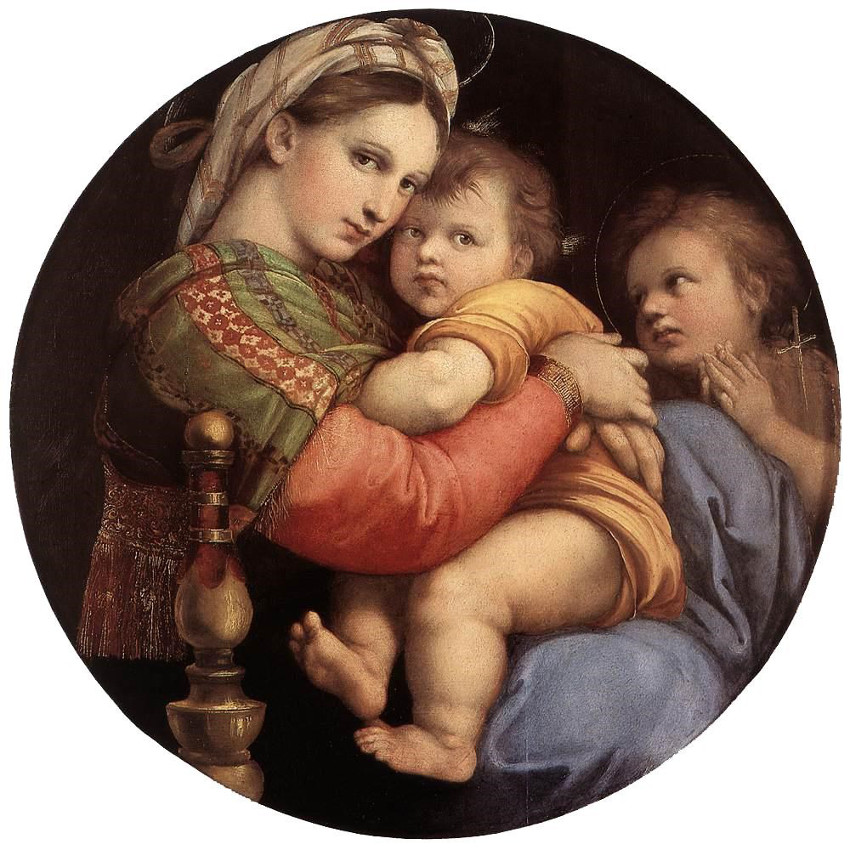

1. Raphael. Madonna With Child.
And now let us look at the picture for a moment as though we knew nothing of the Christian world-conception. Let us consider it in the way Herman Grimm once spoke of it, simply as an expression of the deep mystery of the relation of the mother to the child. A mother with her child: Once more, the highest means of expression have been found by Raphael for one of the most mysterious themes in the whole Cosmos, as it lies before us human beings living in the Physical. Thus even if we take the pure picture of Nature — the mother and child — apart from the world-historic happenings, once more the thing is perfect in itself, the highest of its kind.
It is always so with Raphael. His themes are of universal significance, and perfectly expressed, — the means of expression proceeding from those streams and influences which we recognise as characteristic of the South. Always, however, his themes must be seen in the context of great universal meanings. We can regard them from a Christian aspect (and the above two points of view are by no means the only ones), — looking at it in a Christian way, the theme places itself at once in a great context of Nature. Again it rises free from the individually human; we seem to forget the human being that worked to create it — the human being, Raphael himself. Behind the artist stand great cosmic perspectives — world-conceptions coming to expression in him. This, indeed, is to characterise such an artist as Raphael, as the artist of an epoch that was drawing to it close: the Fourth Post Atlantean epoch. Such epochs, when they draw near their end — or when their inner essence reaches beyond the boundary of times, often bring forth their very highest.
We shall presently see how very different it is when we consider in this light, say, the personality of Albrecht Dürer. There it is altogether different. But you might also think of the Sistine Madonna, even as we have now spoken of the Madonna della Sedia. Again we should have to say: What is here placed before us interests us, above all, inasmuch as it stands out against the background of a great world-conception. Without this background of a great world-conception, the Sistine Madonna is, indeed, unthinkable.
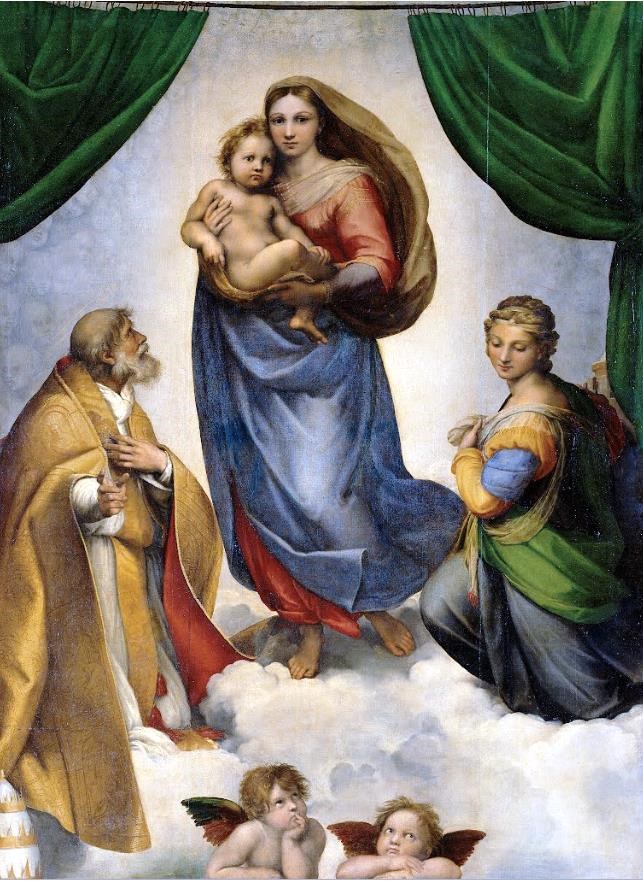

2. Raphael. Sistine Madonna With Child
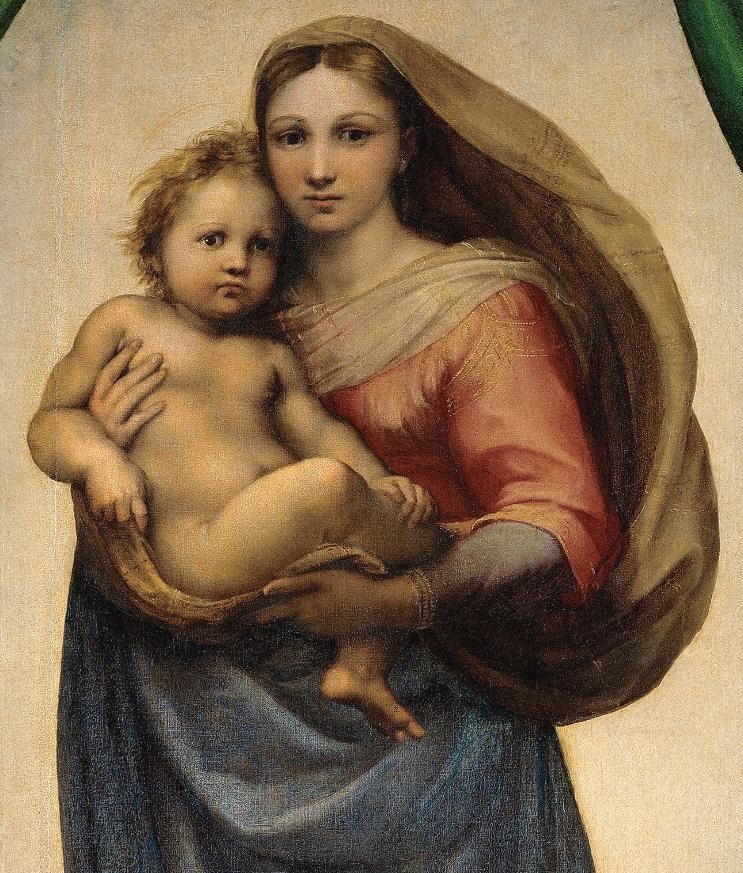

3. Raphael. Sistine Madonna With Child (detail)
Looking at some of Raphael's pictures today, let us bear in mind the aspect which has thus been characterised. For Raphael to create in this way — for his pictures to arise out of a mighty world-perspective — something of cosmic law and principle had to be working in his very soul. This is, indeed, the case. It comes to expression in the remarkable course of his life, which was already emphasized by Hermann Grimm. Raphael's work takes its course in regular cyclic periods. At the age of twenty-one he creates the Sposalize; four years later the Entombment; four years after this he completes the Frescoes of the Camera della Segnatura; four years later, once again, the Cartoons for the tapestries in the Vatican and the two Madonnas. And finally, four years after this, at the age of thirty-seven, he is working at the Transfiguration, which stands unfinished when he leaves this physical plane. In cyclic periods of four years, something of the nature of a cosmic principle works in Raphael. Truly, we here have something that proceeds from a great cosmic background. Hence Raphael's work is so strongly separated from his personality. Again and again the question comes to us: How is it that the themes — and they are world-historic themes — come to expression in his work so perfectly; so self-contained, so inwardly complete?
Down to this day, the study of Art derives — more than from any other source — from that great Art in the center of which is Raphael.
The study of Art in the exoteric life today is more or less of this kind. All its available ideas have been learned from the Art which finds its highest expression in Raphael — the Art of the Italian Renaissance. Thus in the outer life the concepts to express this Art are the most perfect, and all other Art is measured by this standard. The works of this Art are the ideal, and we have few words at our disposal, few concepts and ideas, even to speak of any other streams in Art, specifically different from this one. That is the unique thing.
And now we will let pass before our souls a number of pictures by Raphael, most of which we have not yet seen in these lectures.
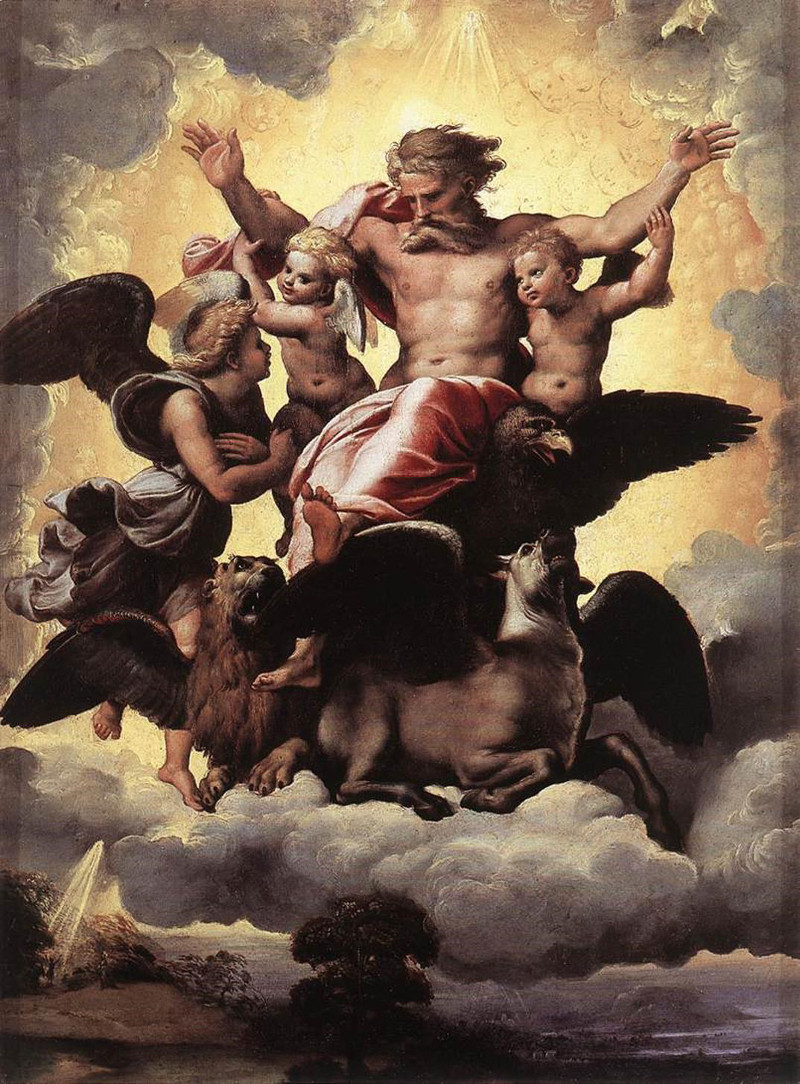

4. Raphael. The Vision of Ezekiel. (Florence, Palazzo Pitti.)
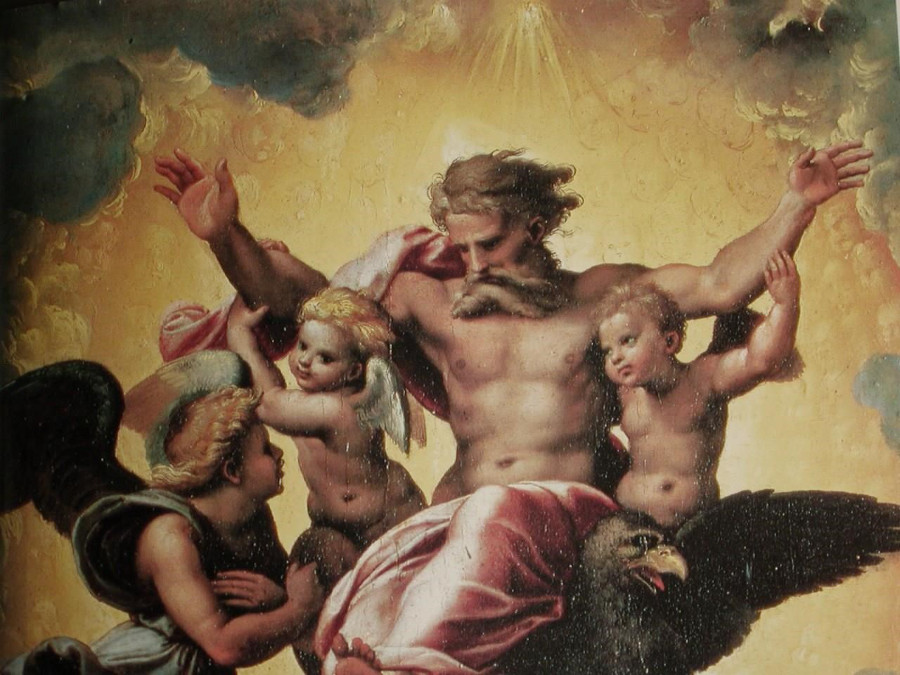

4. Raphael. The Vision of Ezekiel. (detail) (Pitti. Florence.)
The ideas, the living conceptions, out of which such a picture proceeded even in Raphael's time, are naturally no longer near us today. To represent so truly this wandering of the soul in human form through the spiritual world, would no longer be attainable today for those who have not Spiritual Science. The animal nature below expressed what man has cast aside from himself, but it is still there, needless to say, even in his etheric body, and we find it there when the etheric is freed from the physical. The union of the soul with something childlike, as it is is represented by the angel figures here, is an absolutely true conception. The conception corresponds to a reality. We must consider man in his full being, such as he really is. In recent communications on the Guardian of the Threshold we had to speak of the Threefold being of Man. This threefold nature of man emerges everywhere, where reference is made to the Spiritual part of man emancipated from the Physical. We find this threefoldness in manifold forms — not symbolic, but corresponding to spiritual Realities. And so we find it here, in the full-grown Man related to the Child and the Beast.
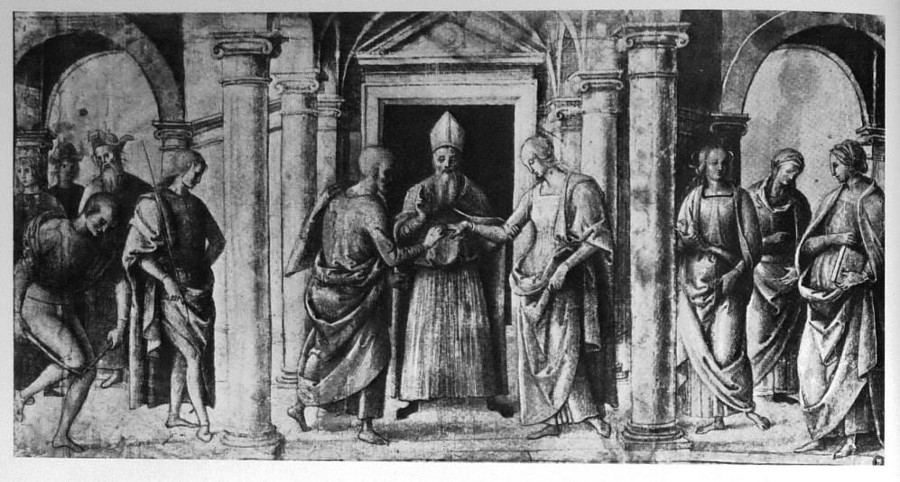

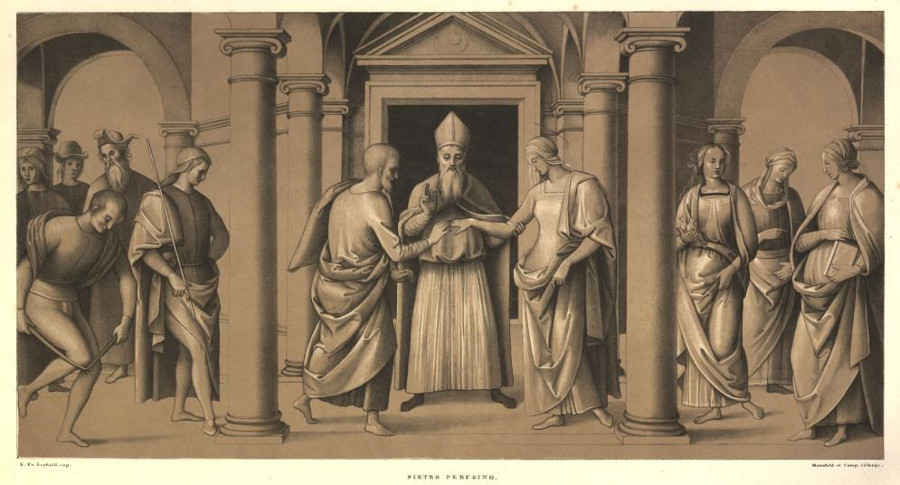

5. Perugino. The Marriage of Maria. (Vienna, Albertina.)
Today we are able to show a study from the Sposalizo, the picture with which Raphael's great career as an artist properly begins. He did this at the age of twenty-one — at the beginning of the four-year period which dominated all his work.
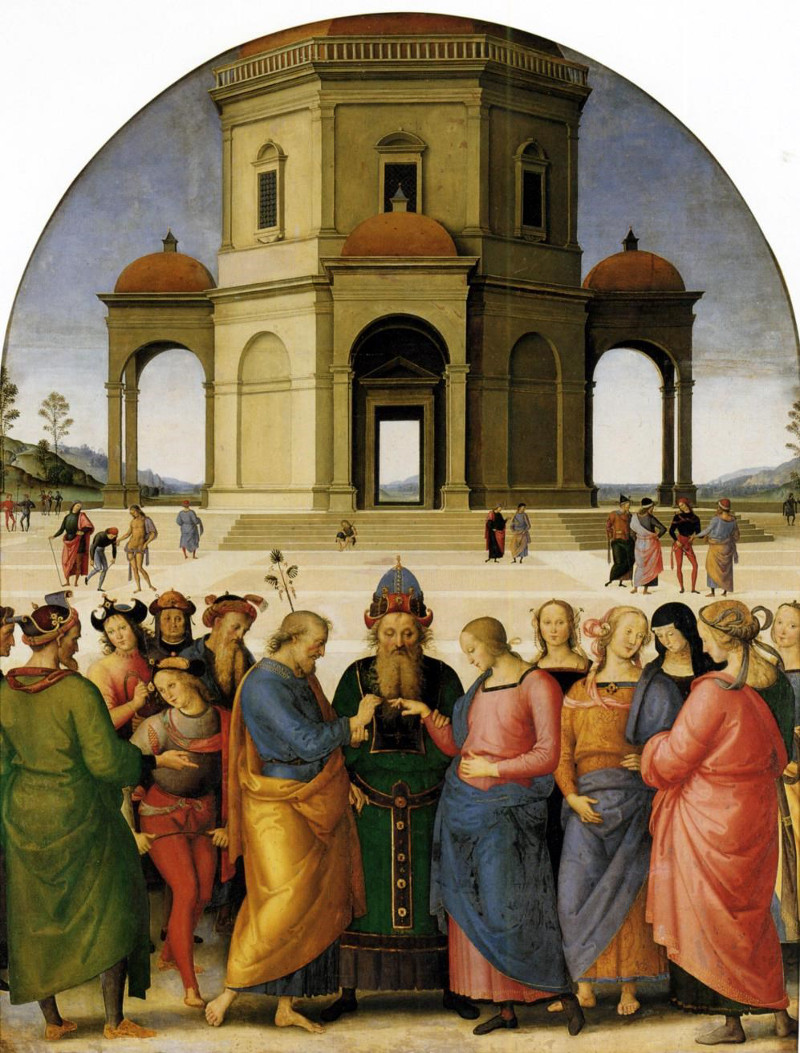

6. Perugino. “Sposalizo”. (Caen.)
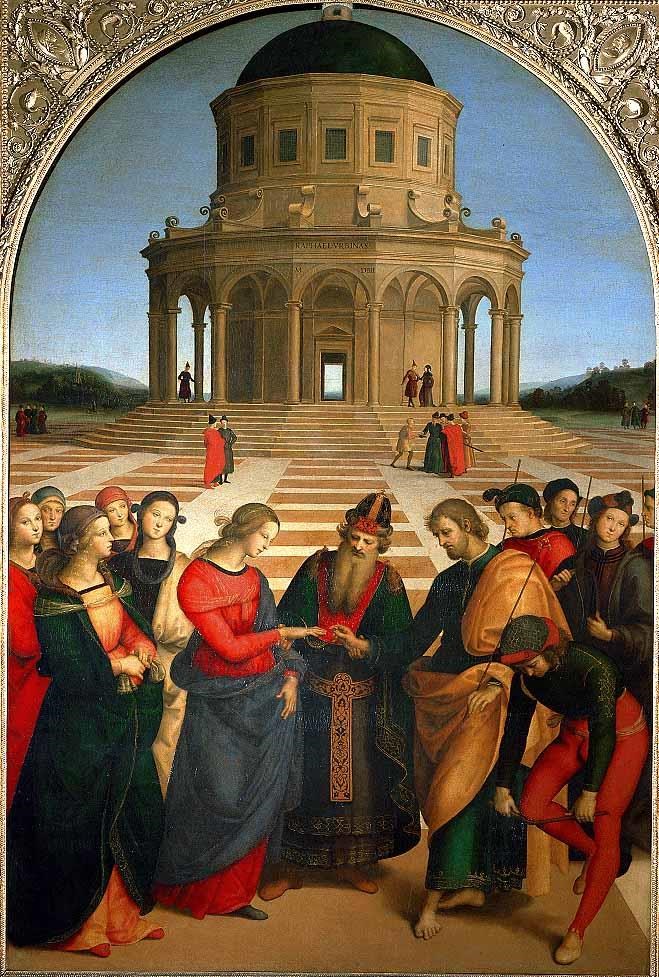

7. Raphael. “Sposalizo”. (Milan, Brera.)
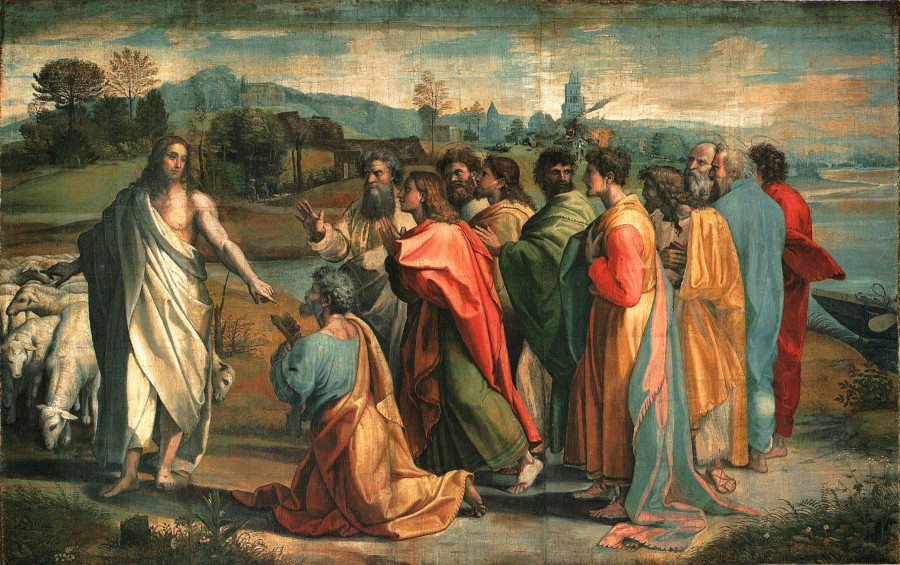

8. Raphael. The Call of St. Peter. (London, Kensington Museum.)
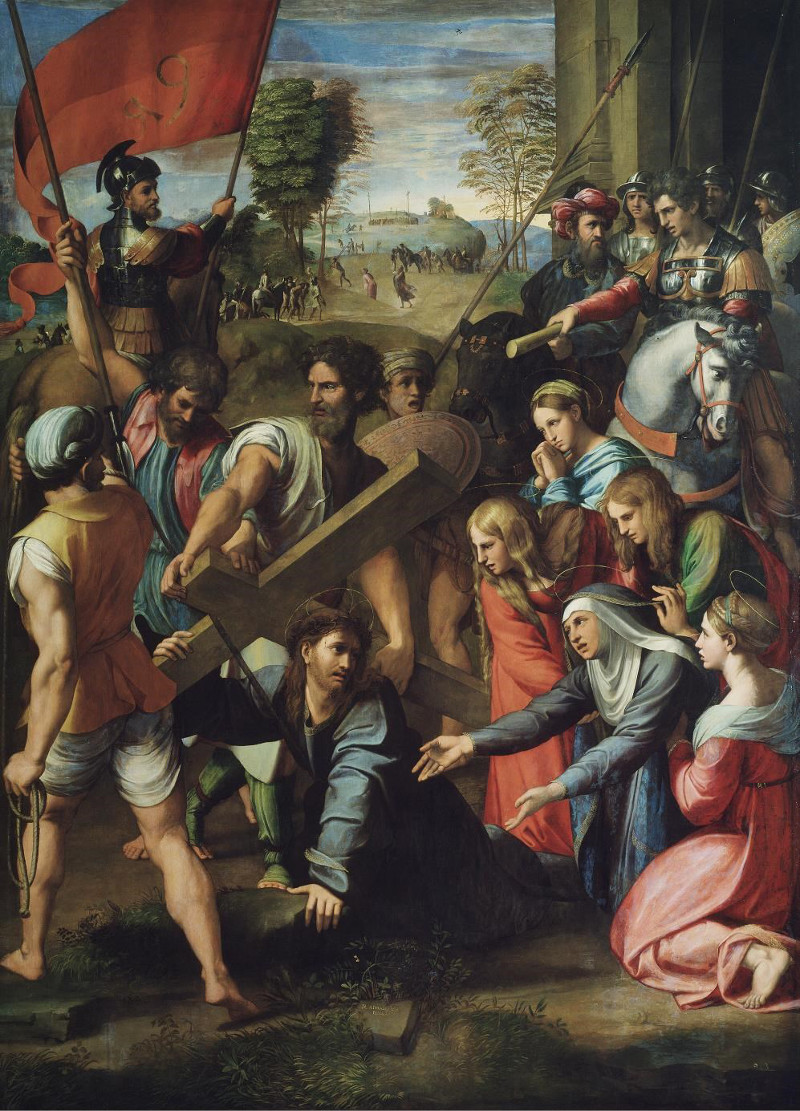

9. Raphael. The Road to Calvary. (Madrid, Prado.)
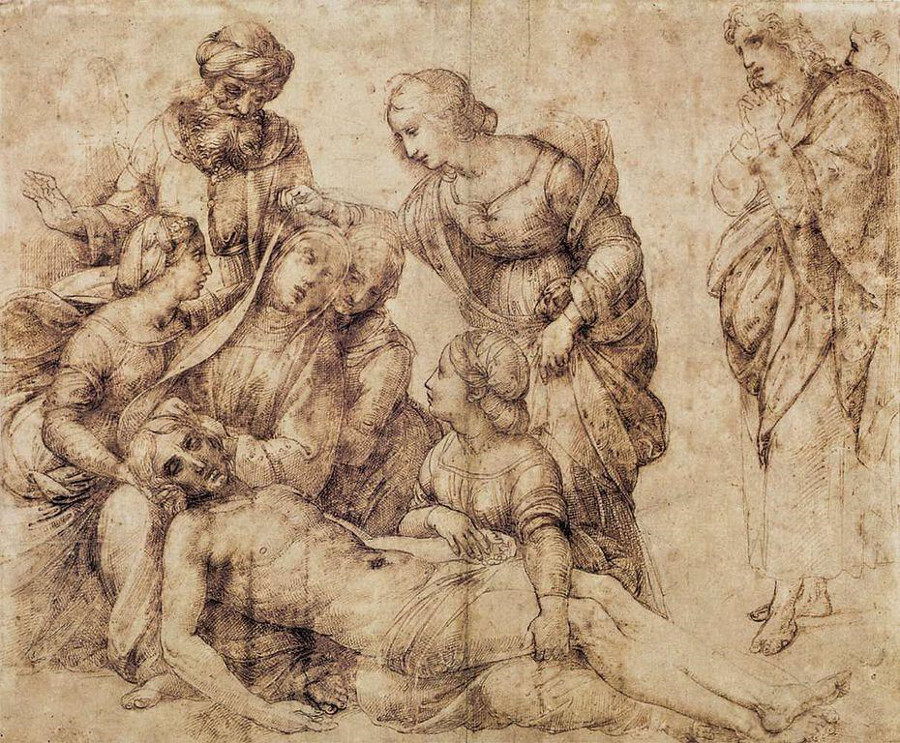

10. Raphael. Sketch of the Mourning for Christ. (Louvre. Paris.)
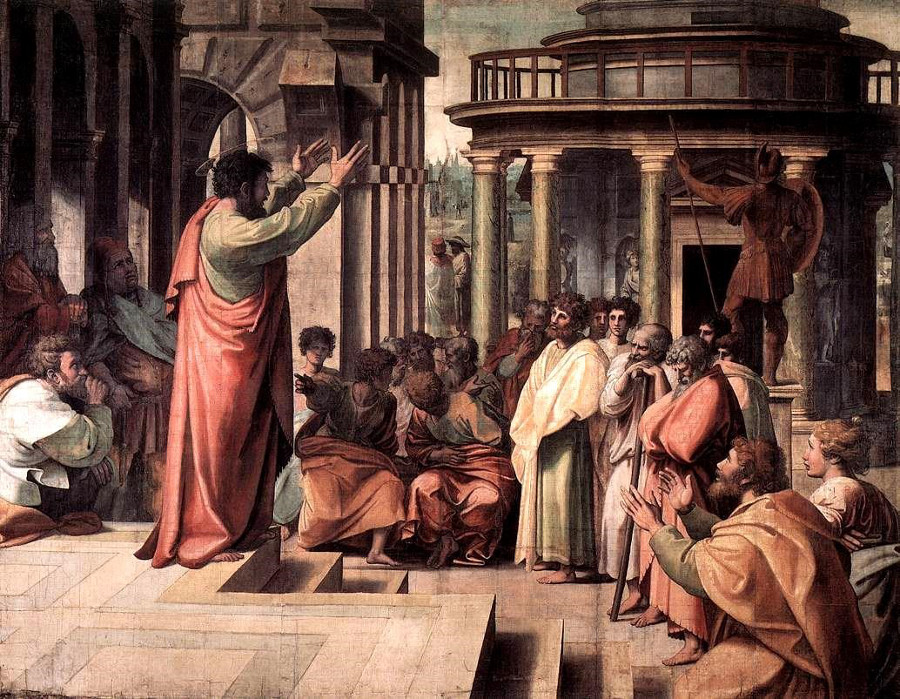

11. Raphael. Sermon of St. Paul at Athens. (London, Kensington Museum.)
We will now show once more a reproduction of the so-called “Disputa,” with certain details.
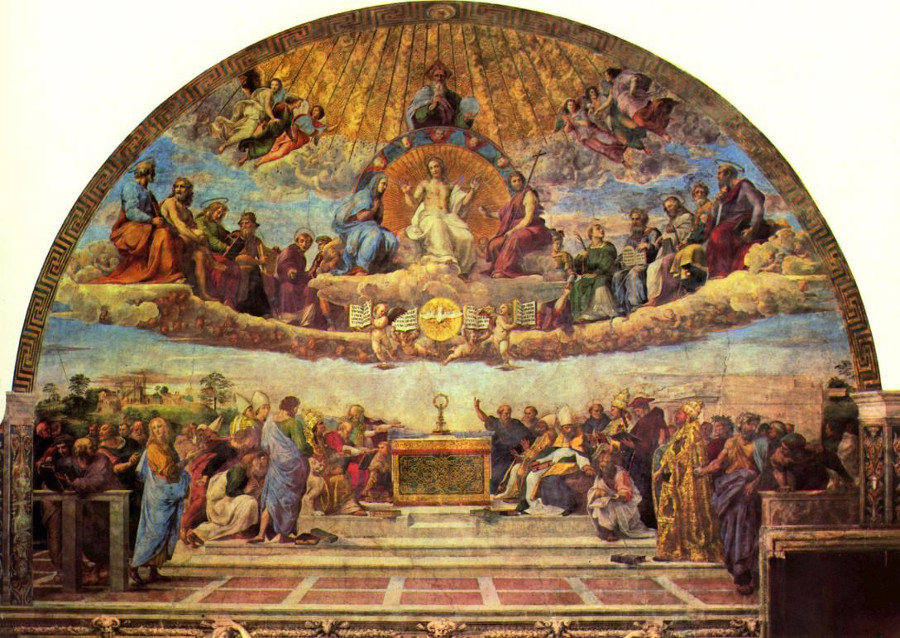

12. Raphael. Disputa. (Vatican. Rome.)
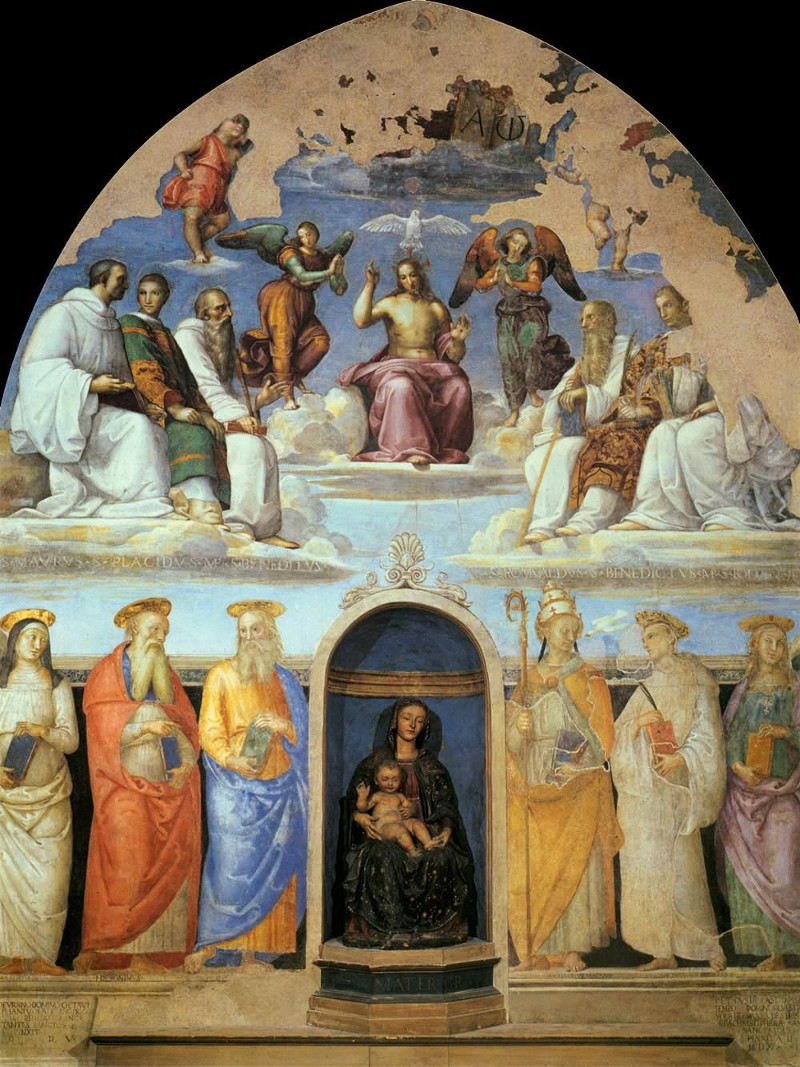

13. Raphael. The Holy Trinity. (Perugia, San Severo.)
The Holy Trinity, as it is called.
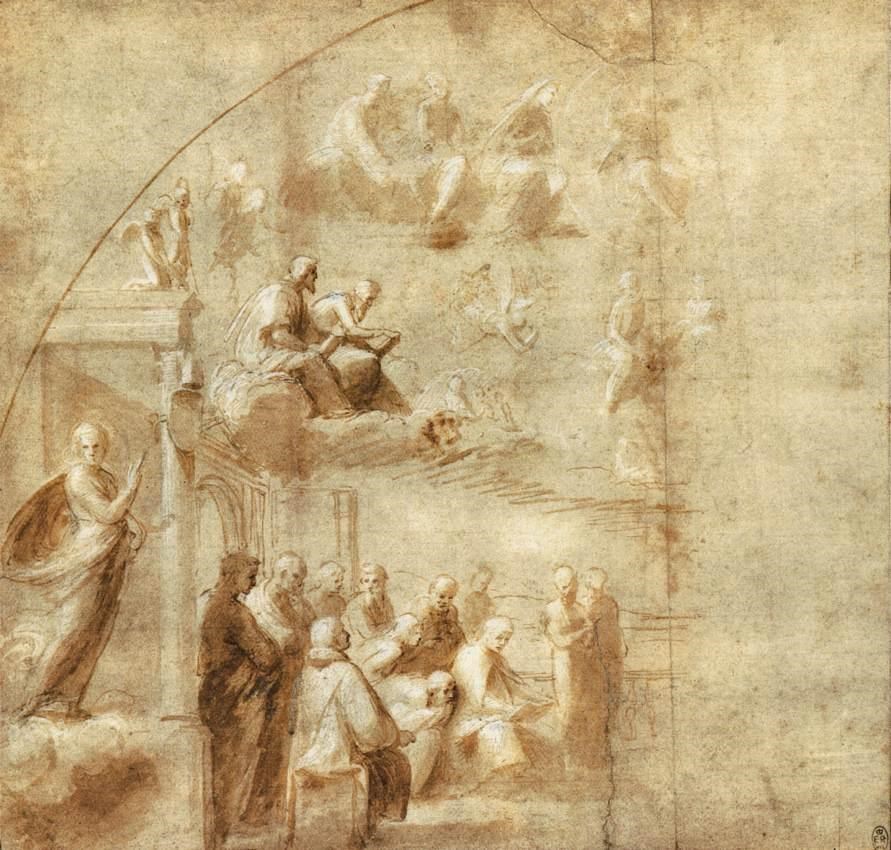

14. Raphael. Sketch for the Disputa. (Windsor.)
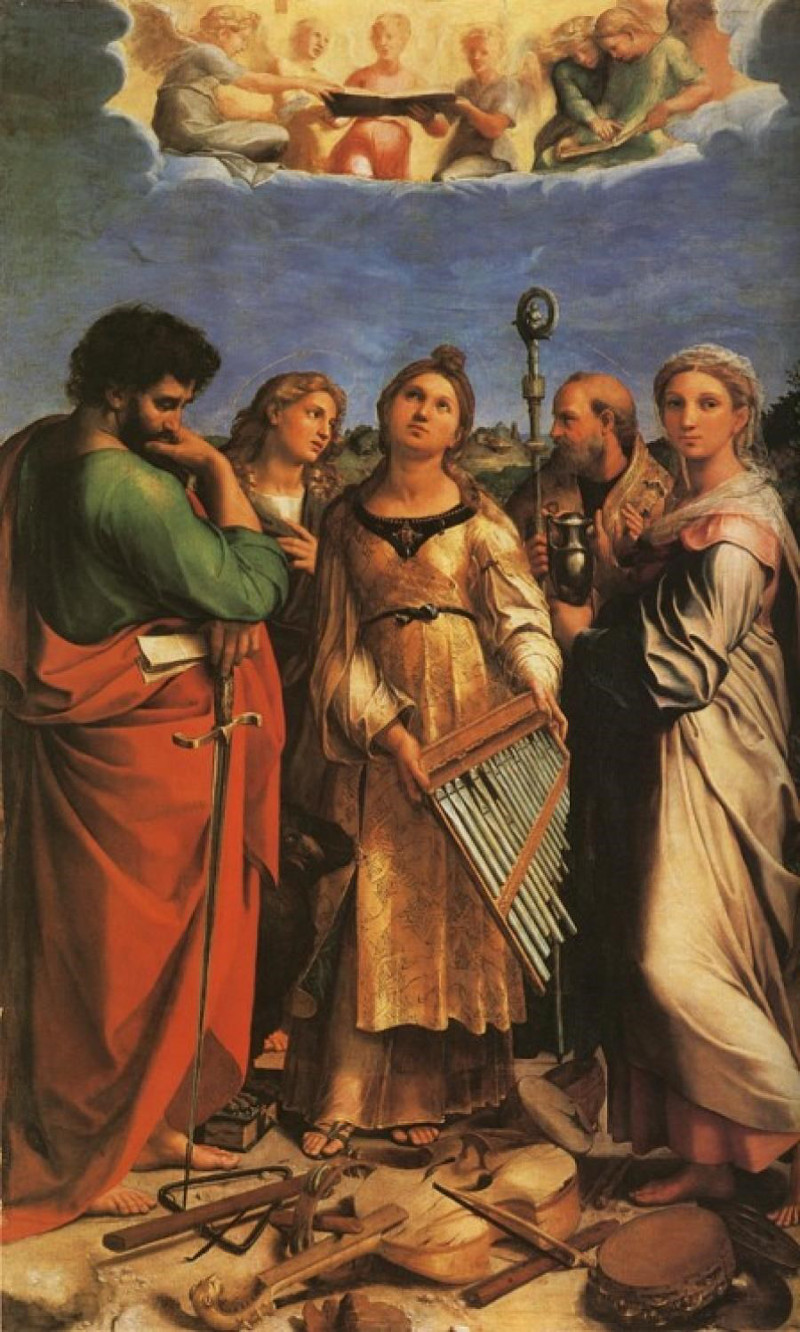

15. Raphael. St. Cecilia. (Bologna.)
And now, as an example of Raphael's portraiture: —


16. Raphael. Cardinal Bihbiens. (Pitti. Florence.)
The next two are examples of his tapestries in the Vatican.


17. Raphael. The Miraculous Draught of Fishes. (Tapestry in the Vatican.)


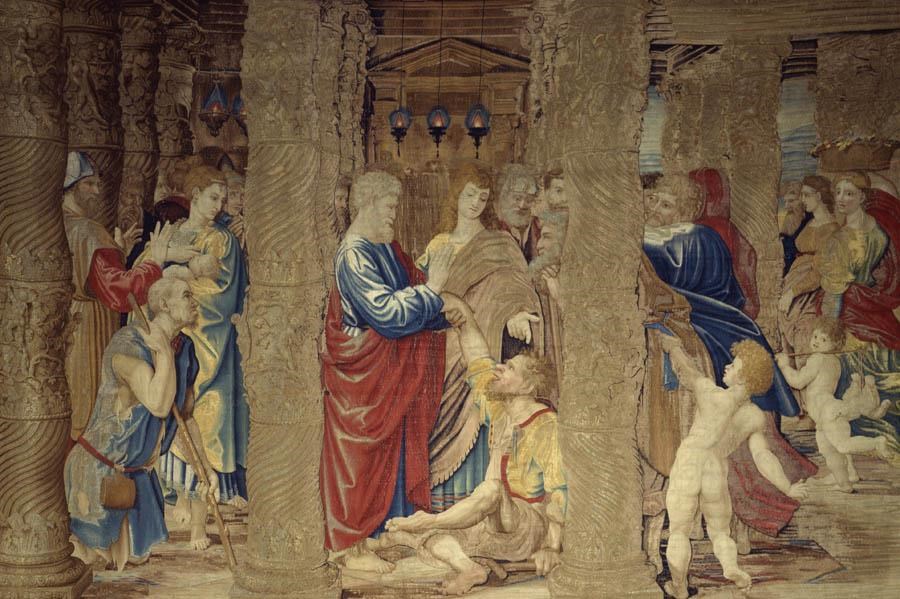

18. Raphael. The Healing of the Lame. (Tapestry in the Vatican.)
These are the things of which Goethe said that nothing he had known till then could compare with them in greatness.
Looking back once more over the pictures by Raphael which we have seen today, I beg you observe how we may recognise in them the echoing of a mighty tradition of great Art. Even the sketches which we have shown today reveal this most especially. Raphael's work is the last, the highest, the closing act in a great tradition. There is also another point I would ask you to consider. Think of the picture of the Sermon of St. Paul and others — the “Disputa,” for example. You may take any one of those that we have seen today. In every case, having distinguished the subject of the picture, you may naturally ask yourself about the event or personality represented. But it will never be sufficient to answer: The subject is such and such; it represents this or that. In Raphael's case you will have to ask: How is the artist contriving to express — whatever the subject is — in accordance with the ideas and canons of great Art? We cannot merely ask: How would St. Paul actually have lifted up his hand to speak? With Raphael we must ask: What angle will the arm have to make with the body according to aesthetic laws of balance and proportion? And so forth ... A magic breath is poured out over it all, — a magic breath of aesthetic traditions, of harmony and balance. Look at the boy who stands here, in this picture. It is not enough to ask: What is going on in the soul of the boy? Your question must, rather, be directed to these laws of artistic harmony. See how the line of the arm, reaching out on either side, is placed into the composition. In short, you can distinguish what is purely artistic from the underlying subject-matter. Here, however, the artist's power is so magnificent that it draws the subject-matter into its own sphere. With such an artist as Raphael, we may, indeed, pronounce the word, for it is literally true: — “Artistic truth makes all the rest true, — compels all the rest into its circle.”
You cannot apply this saying, in its present meaning, to the works we shall now let pass before our souls. We will begin with one by Martin Schongauer, who died in 1488.
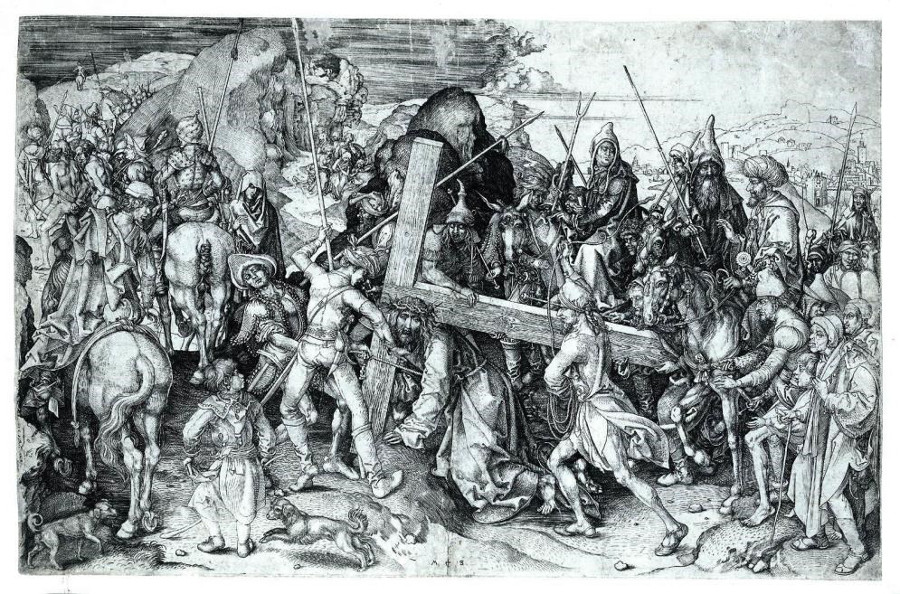

19. Martin Schongauer. The Road to Calvary.
Here you see the very opposite. To begin with, the artist is simply concerned to express his subject. No longer is there poured out over it the magic breath of a peculiarly aesthetic truth, the climax of a great tradition. Here the effort is, to the best of the artist's technique and ability, with the artistic means at his disposal, to bring to expression what is there in the souls of men. Here the world speaks to us directly — not through the medium of a tradition of great Art.
We will now let work upon our souls the personality of Albrecht Dürer; showing a number of pictures which we did not see in the former lectures. In Albrecht Dürer, whom we may speak of as a contemporary of Raphael, we have before us an altogether different personality. It is impossible to think of Dürer's works in the same way as of Raphael's. In Dürer's case we shall not easily forget the personality, the human being. Not that we must always necessarily imagine him; but the pictures themselves are eloquent of all that is direct and intimate and near to the human soul, springing from the soul with elemental force. Raphael paints with the ever-present background of great world-perspectives. He is only conceivable if we imagine, as it were, the Genius of Christianity itself painting in the soul of Raphael. And, again, he is only conceivable as one who stands at the close of a great epoch, during which pupils were learning from their Masters many a tradition of aesthetic law, artistic harmony, — learning that certain things should be done in certain ways, to correspond with the canons of great Art.
In Raphael's works these things are always there before us. In Dürer's work, on the other hand, we feel in the background, as it were, the aura of the life of the time in Middle Europe, — the German towns and cities. Invisibly his pictures are pervaded by all that blossomed forth in the free life of the cities, working its way towards the Reformation. Nor does he stand before us with any cosmic perspectives in the background. It is, rather, the ordinary individual man's approach to the Bible and to his fellow-men, bringing his own soul to expression. The Human element can never be separated from his works. We cannot seek in Dürer for a cosmic principle working through his soul, as we can in Raphael. But we may look for something intimate and deep; deeply connected — we cannot say so too often — with the human soul, its feelings and its seeking, its longing and striving.
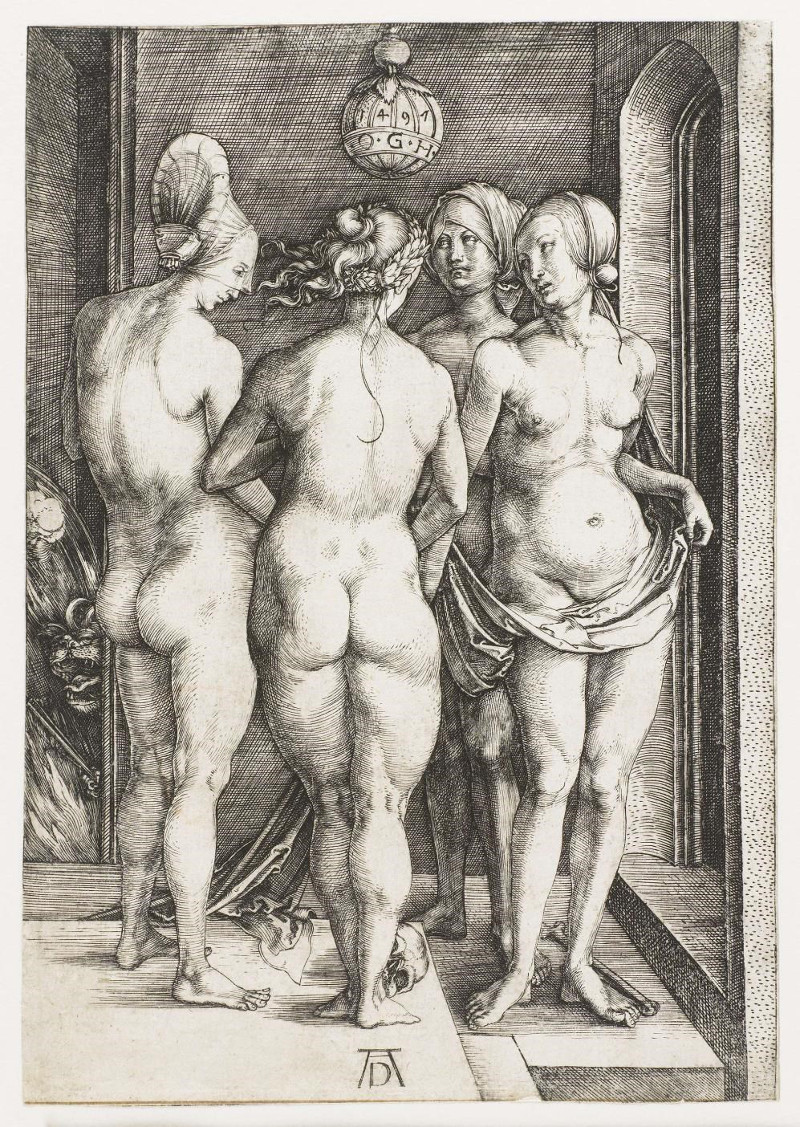

20. Dürer. The Four Witches. (Etching)
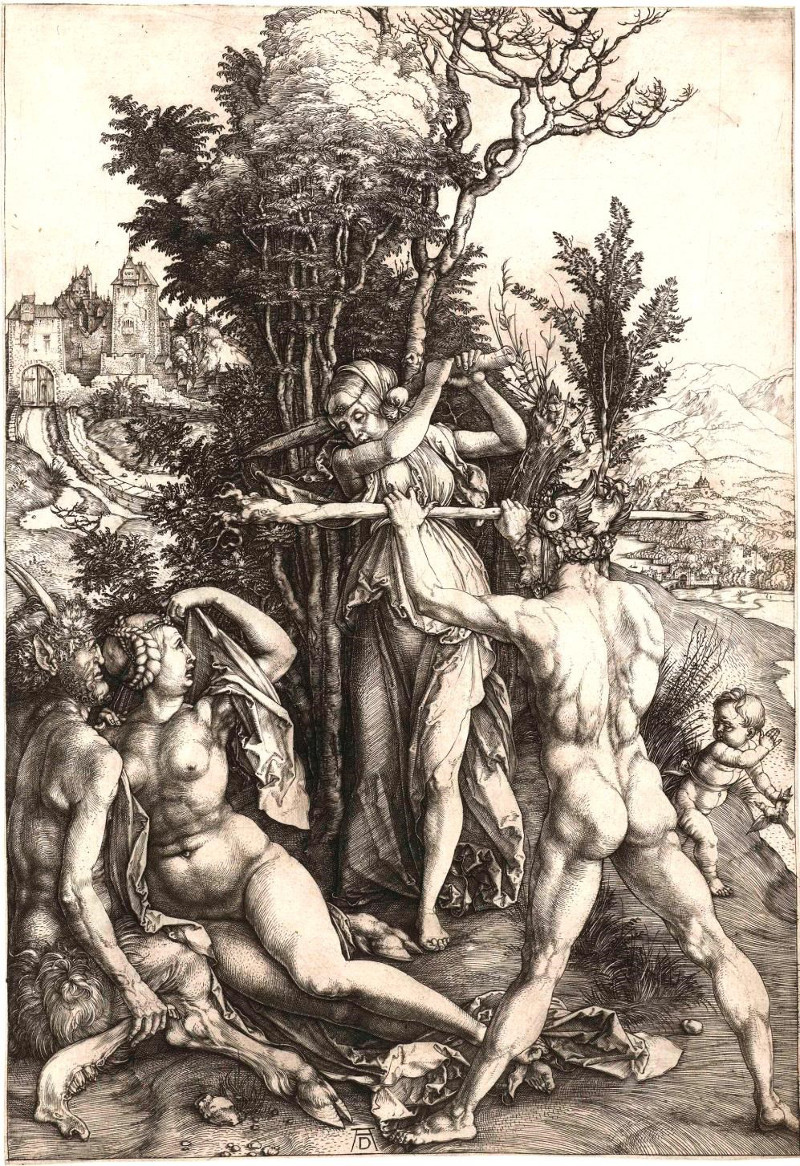

21. Dürer. Hercules.


22. Dürer. Melanchthon Etching.
Here we have a portrait of Melanchthon, the theological bearer of the Reformation, as against Luther, who was the “priestly” bearer.
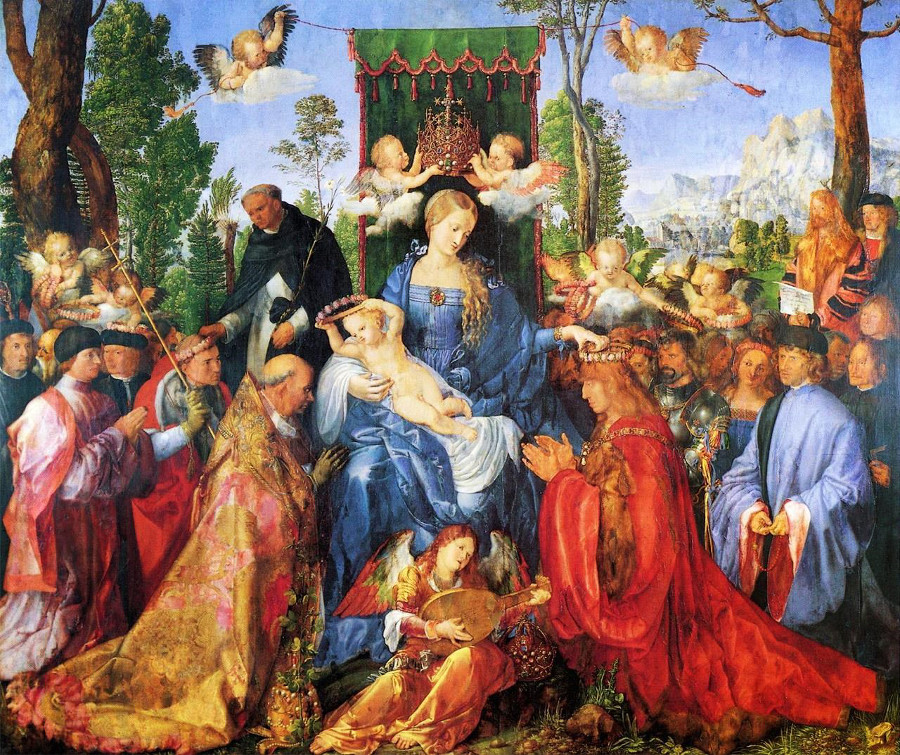

23. Dürer. “Rosenkranzfest.” (Prague.)
This picture is now in the “Rudolfinum” at Prague. The Pope, the Emperor and representatives of Christianity are being crowned with roses by Mary, the Jesus Child and St. Dominic. The two figures against the tree trunk will be shown in detail in the next slide.


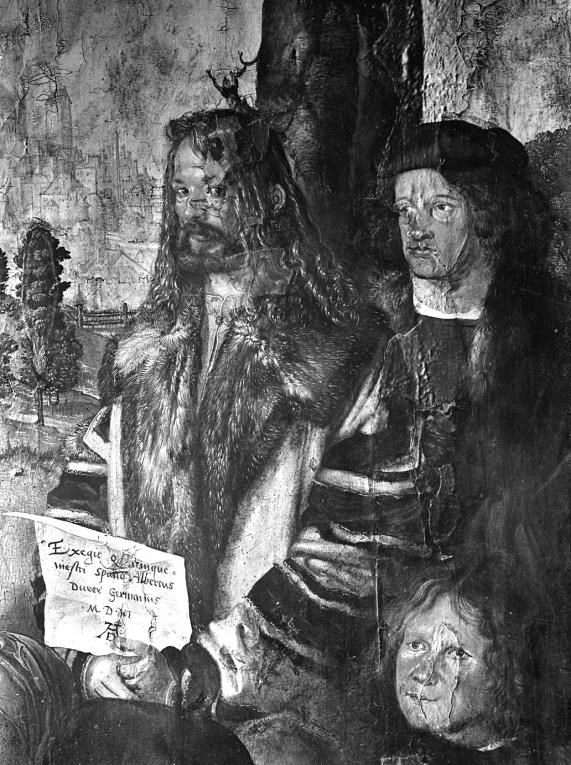

24. Dürer. Portrait of Himself and Pirkheimer. (Detail of the above.)
Further examples of Dürer's portraiture: —
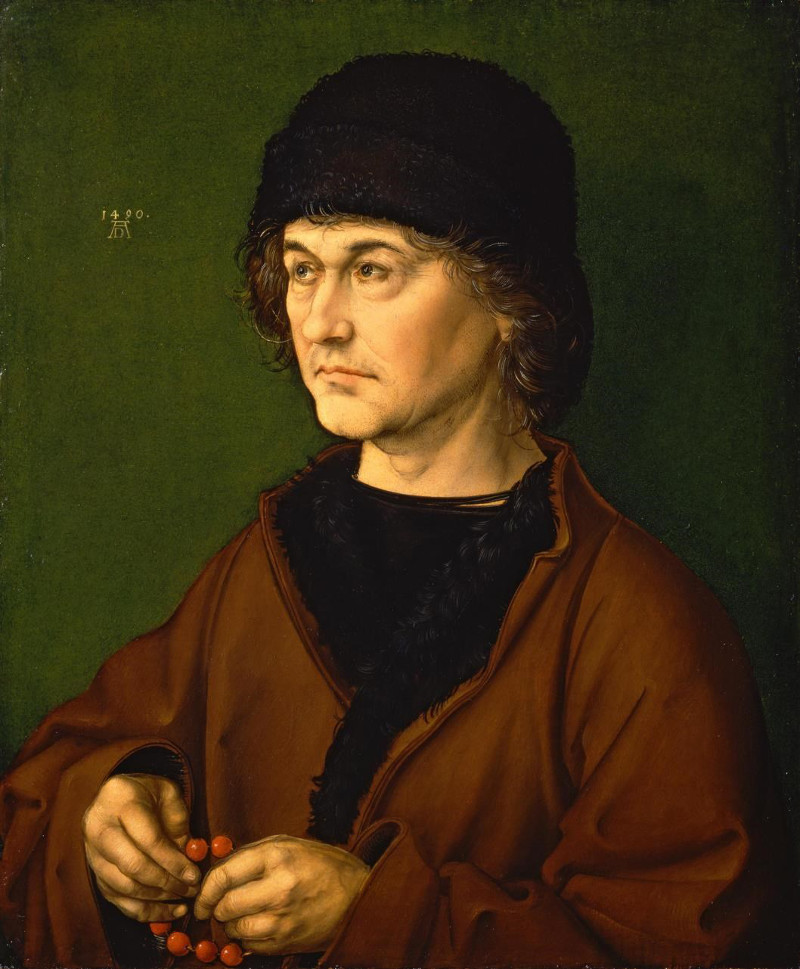

25. Dürer. Portrait of his Father. (Uffizi. Florence.)
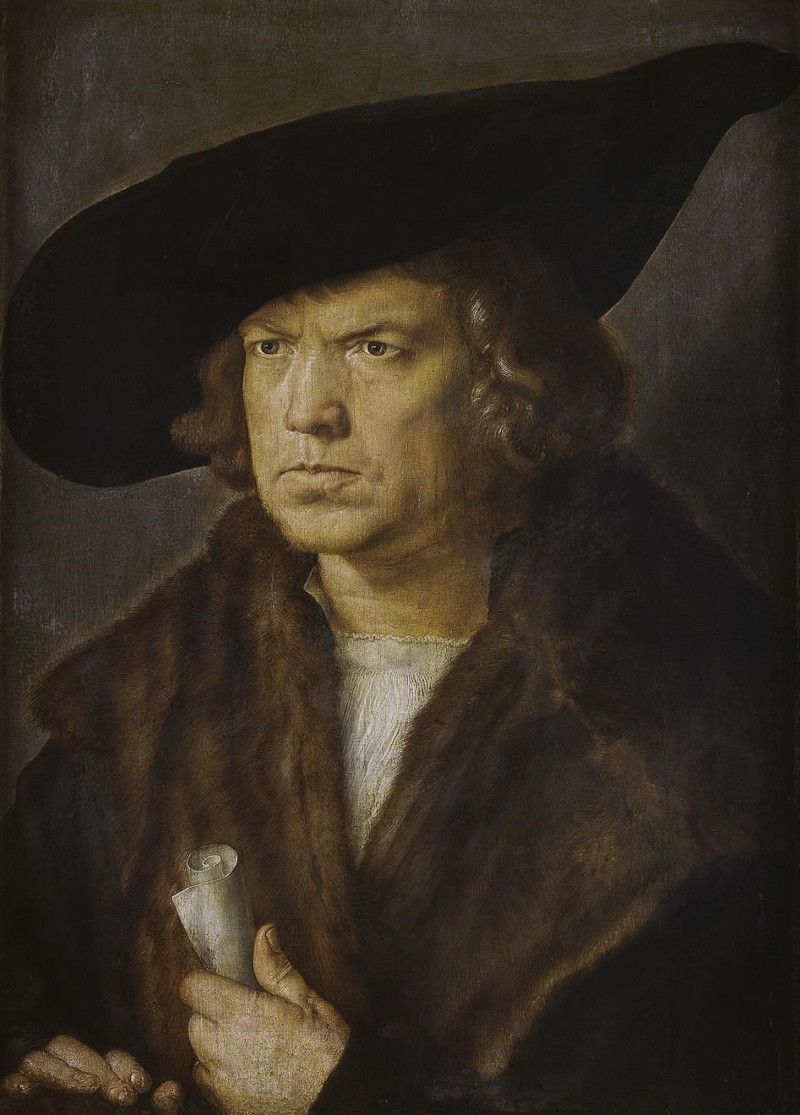

26. Dürer. Portrait. (Prado. Madrid.)
Looking at such a portrait, the whole life of the time comes vividly before you. Truly, in this sense Dürer is an historic figure of the very first rank. No historic document tells us so well, what the people of that time were like.
We shall now show some characteristic examples of Dürer's drawings — etchings and woodcuts. To begin with, from his cycle on the Apocalypse — fifteen leaves, done in 1498.
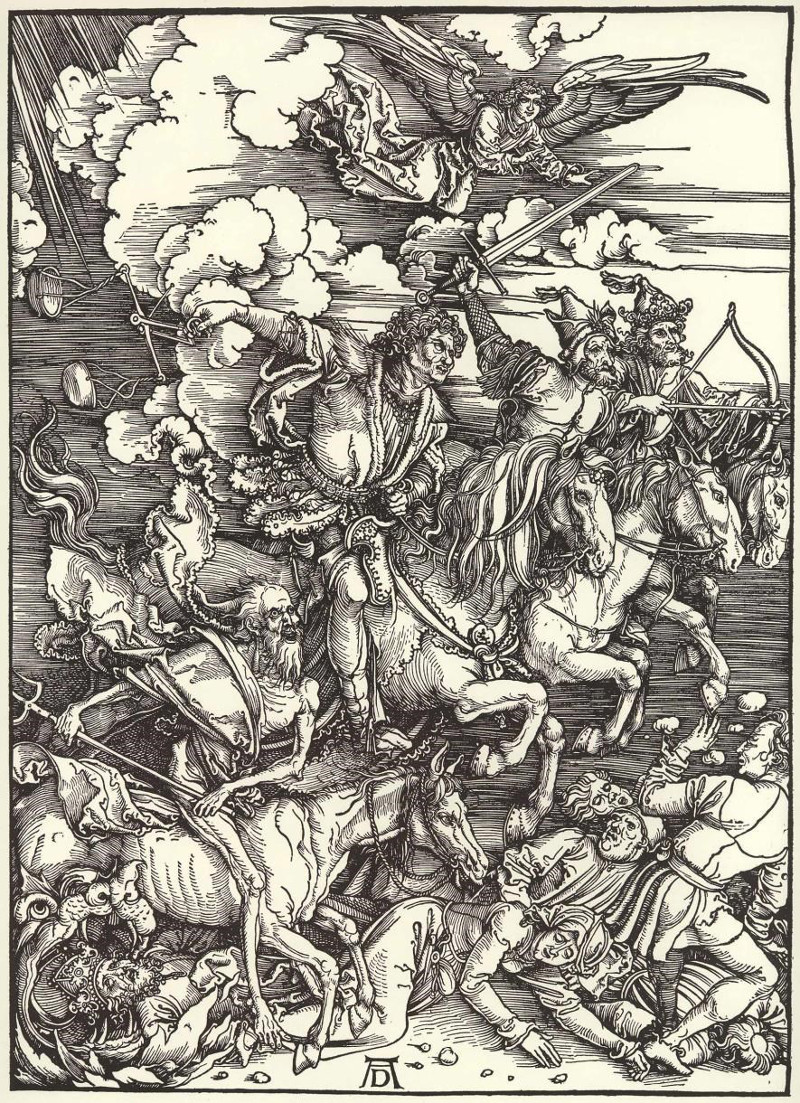

27. Dürer. The Four Horsemen of the Apocalypse. (1498.)
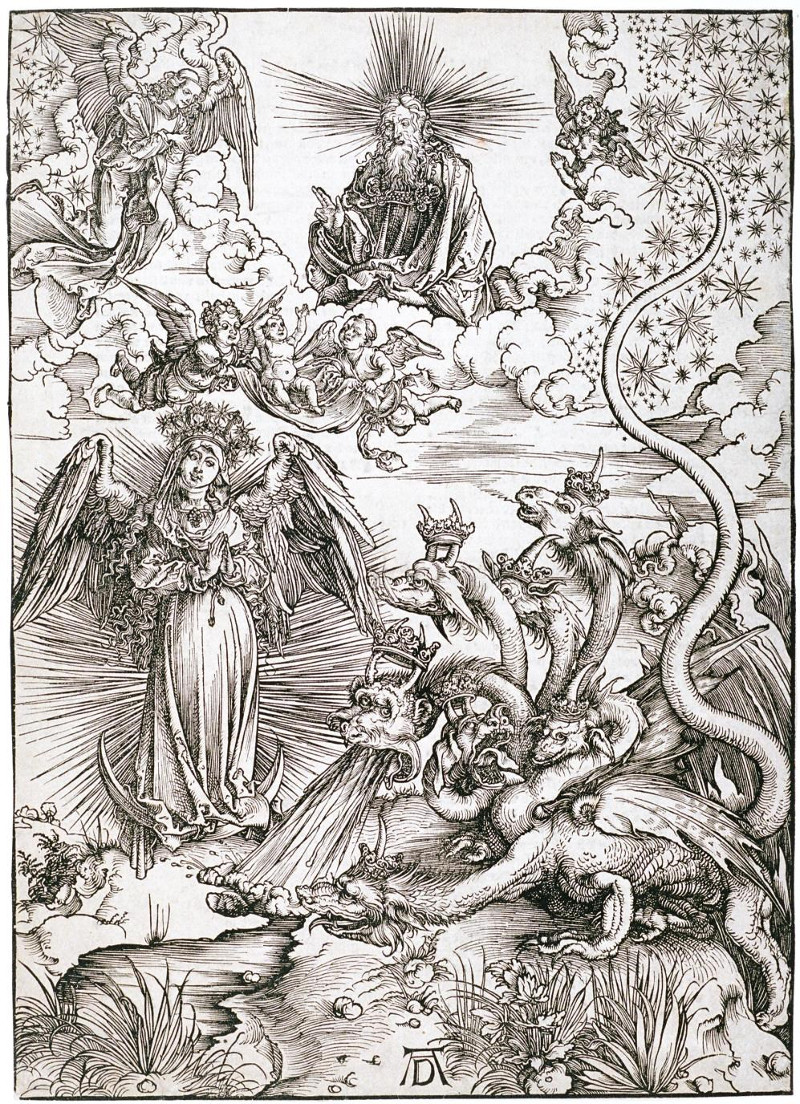

28. Dürer. The Woman Clothed with the Sun and the Seven-headed Dragon (1498.)
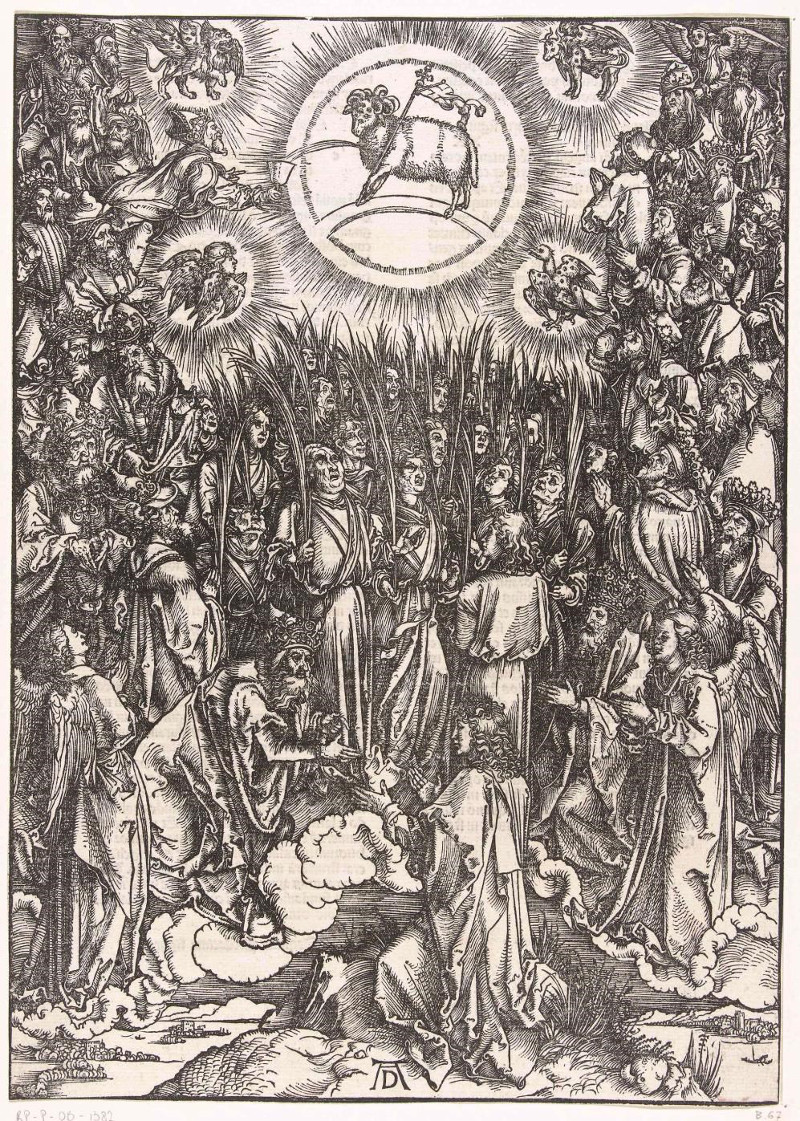

29. Dürer. The Adoration of the Lamb and The Hymn of the Chosen. (1497).
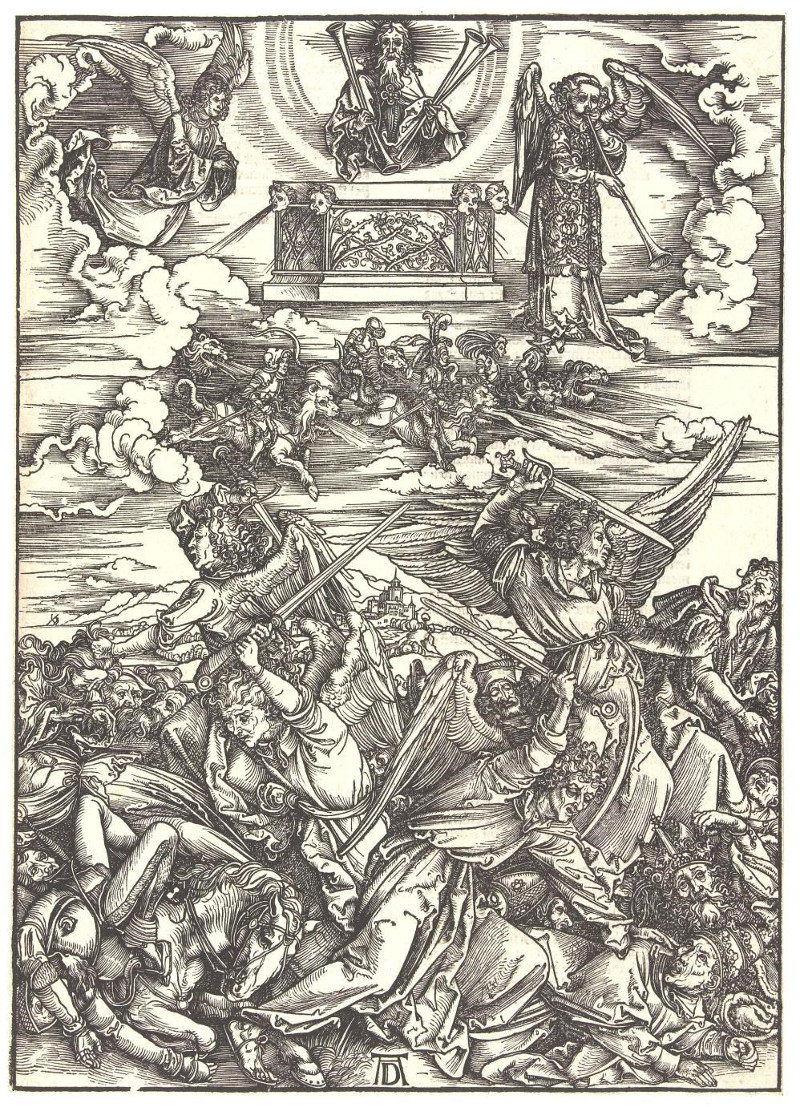

30. Dürer. The Battle of the Angels. (1498.)
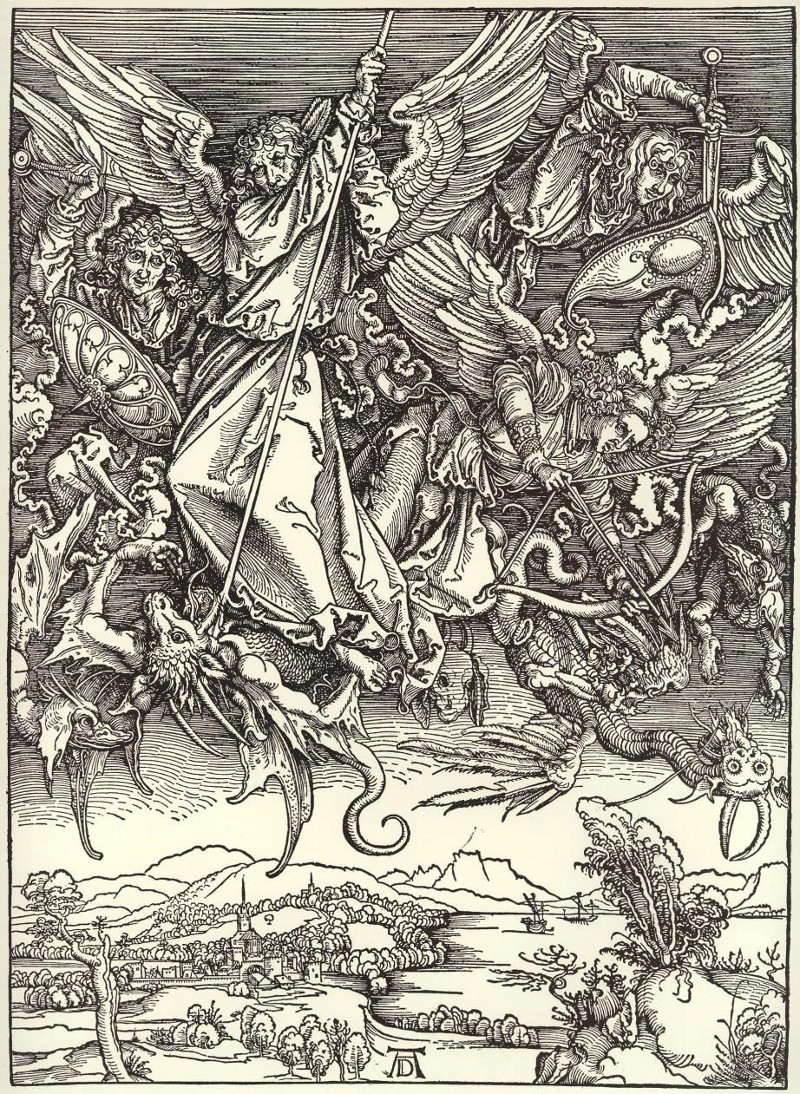

31. Dürer. Michael and the Dragon. (1493.)
And now we will show a number of pictures from the series of etchings of the Passion — known as the “Kupferstich-Passion.”
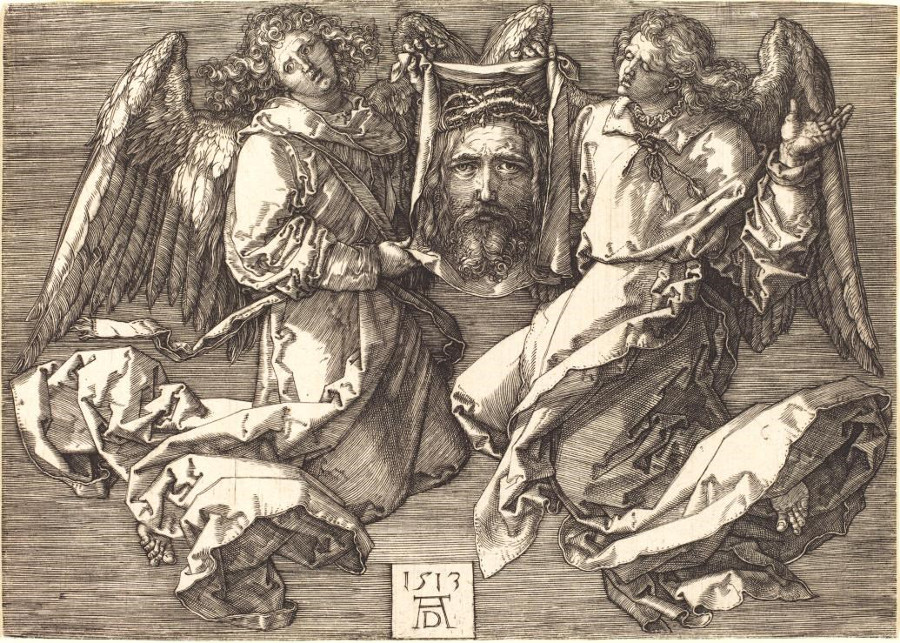

32. Dürer. The Kerchief of St. Veronica. (Etching)
Then the motif that occurs again and again in that time: —
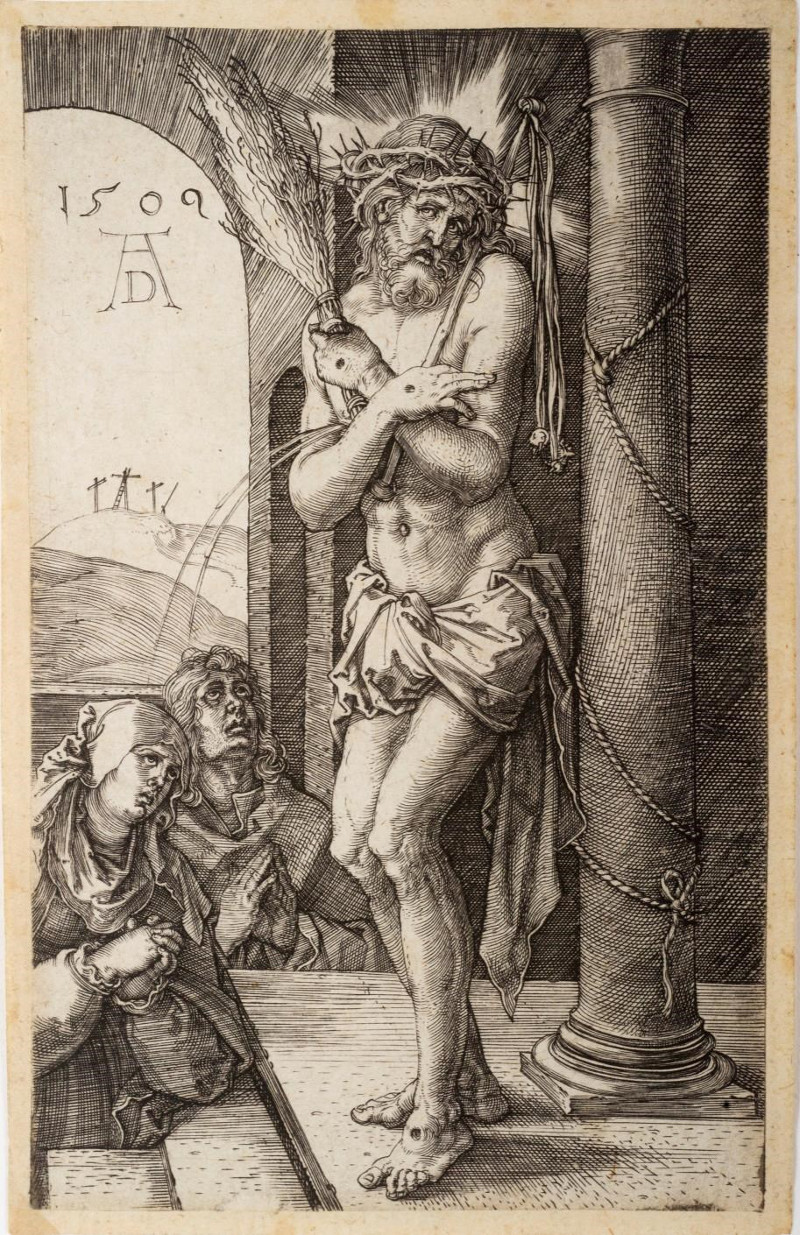

33. Dürer. The Man of Sorrows. (Etching)
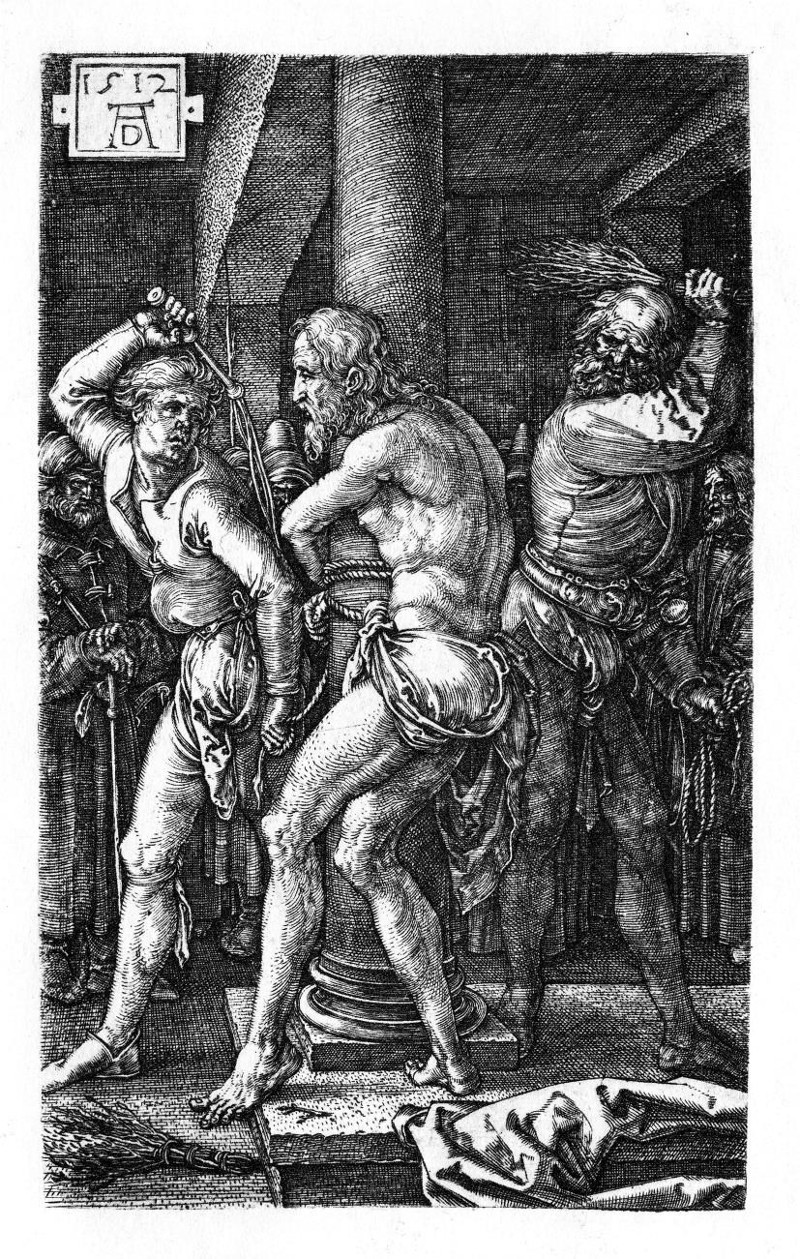

34. Dürer. The Scourging. (Etching)
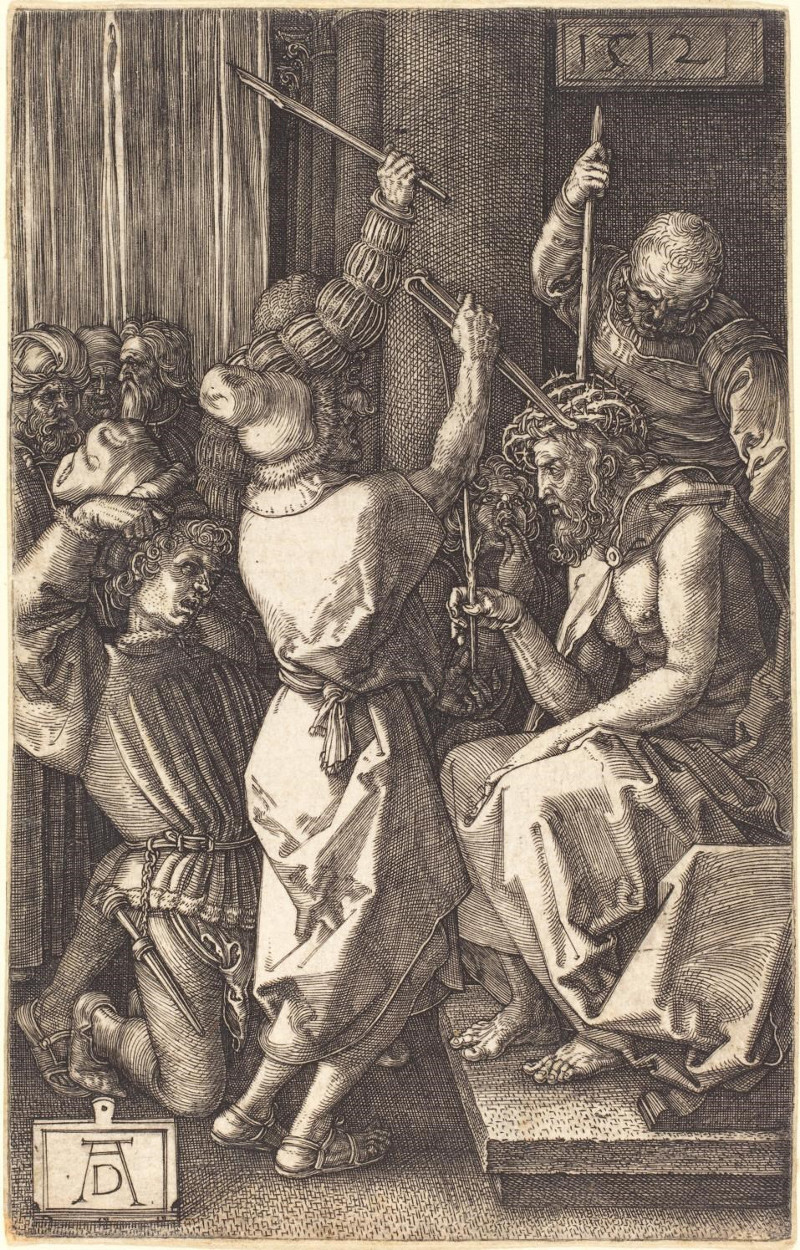

35. Dürer. The Crowning with Thorns. (Etching)


36. Dürer. Ecce Homo. (Etching)
We will next show a number of pictures from the Holzschnitt-Passion — of thirty-six small woodcuts. They are extraordinarily tender and intimate. The first is the title-page: —


37. Dürer. Christ with the Crown of Thorns. (Woodcut)
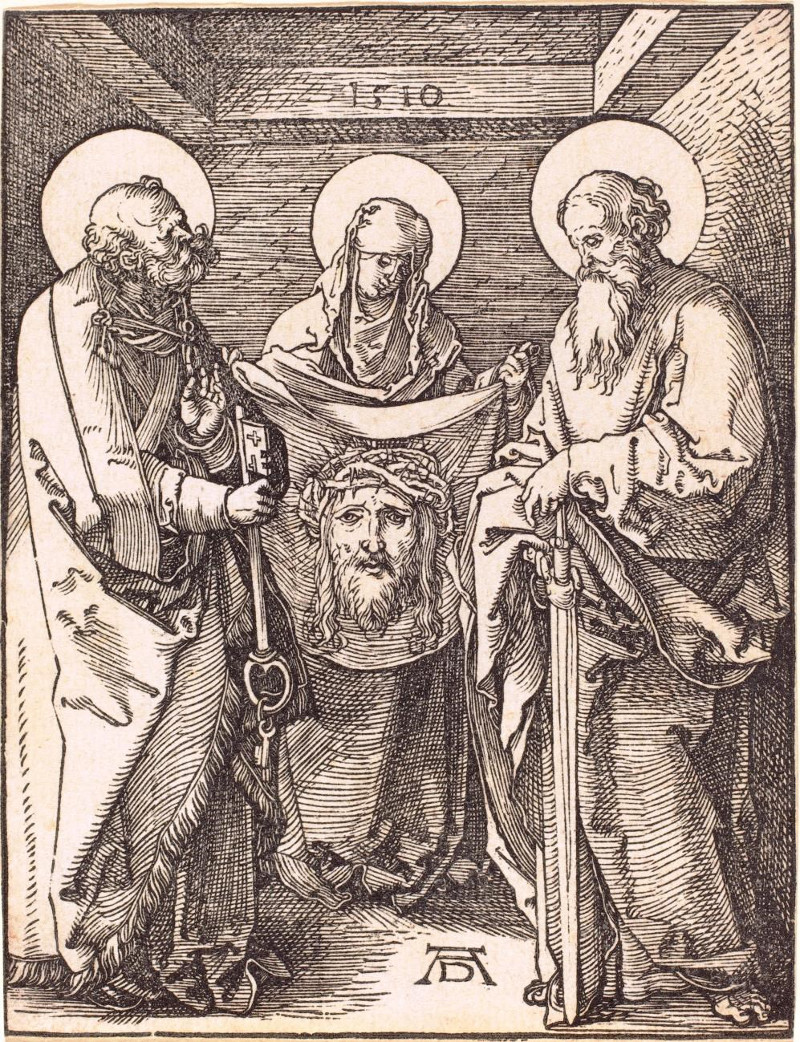

38. Dürer. Saint Veronica. (Woodcut)
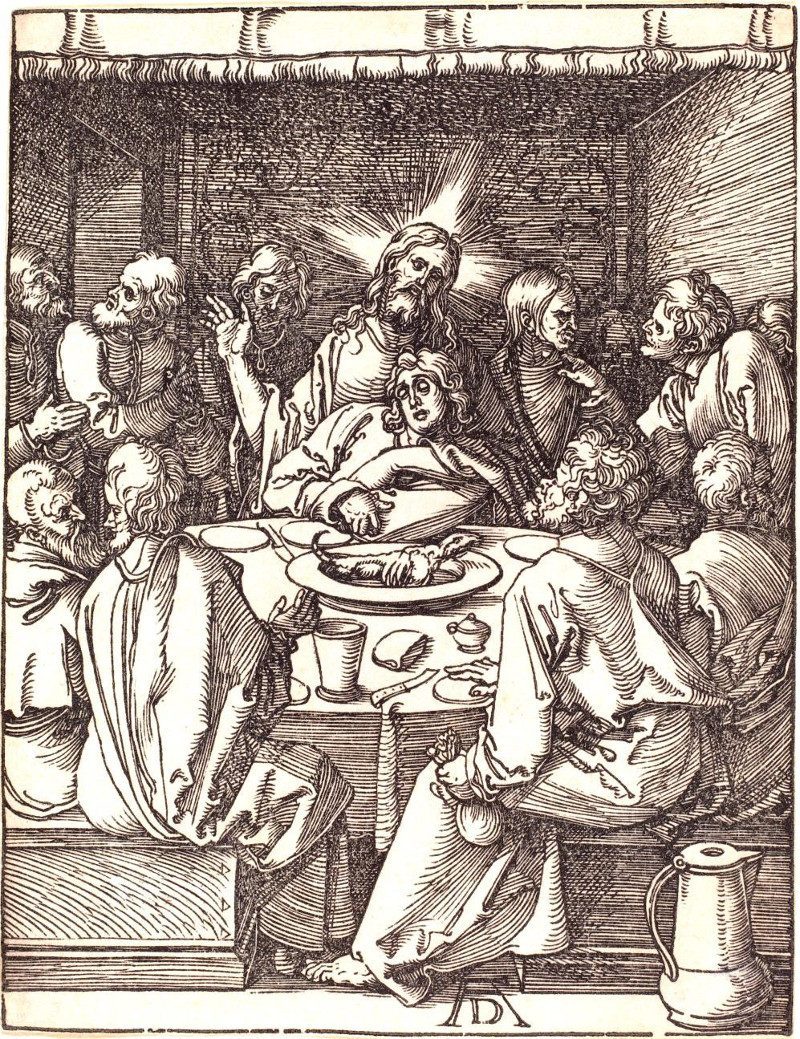

39. Dürer. The Last Supper. (Woodcut)
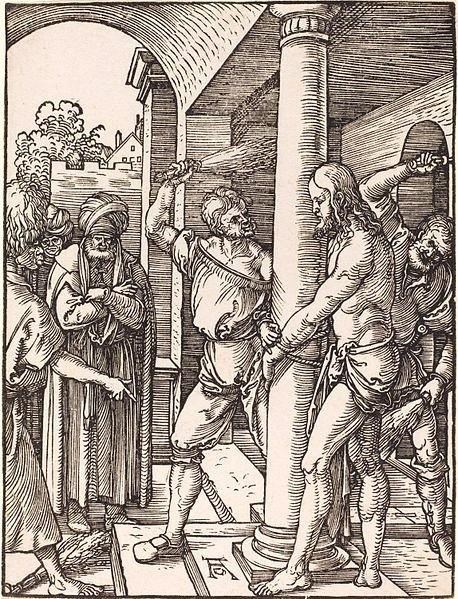

40. Dürer. The Scourging. (Woodcut)
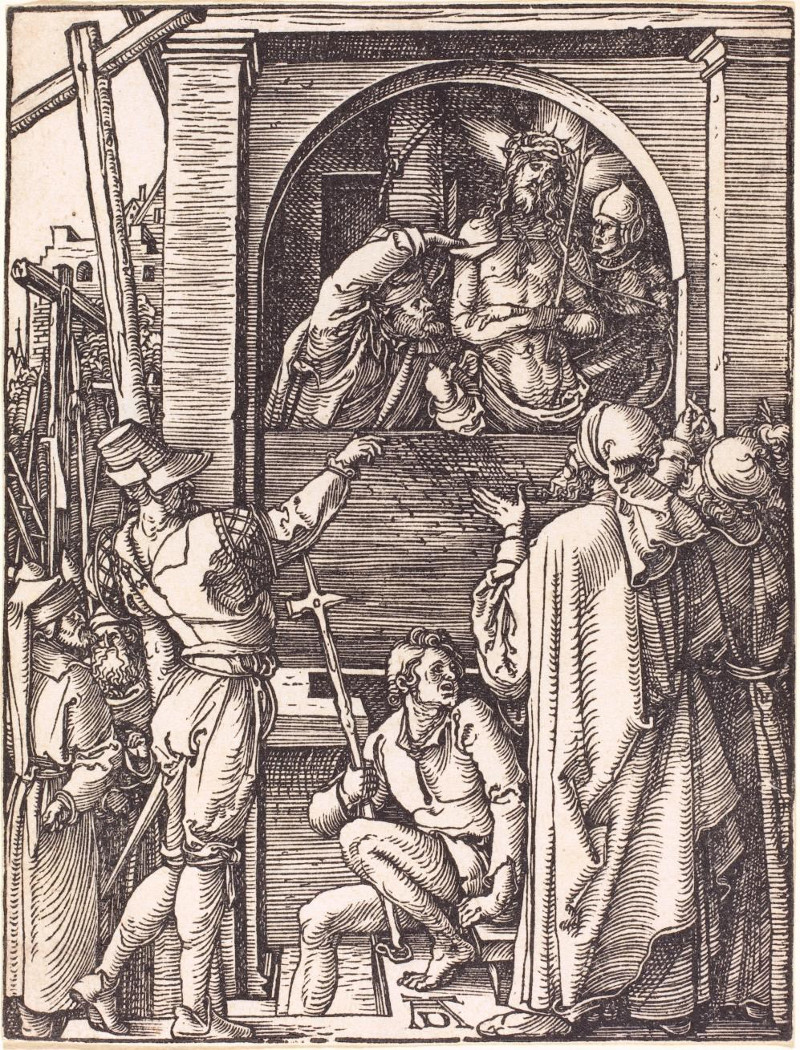

41. Dürer. Ecce Homo. (Woodcut)


42. Dürer. The Way to Calvary. (Woodcut)
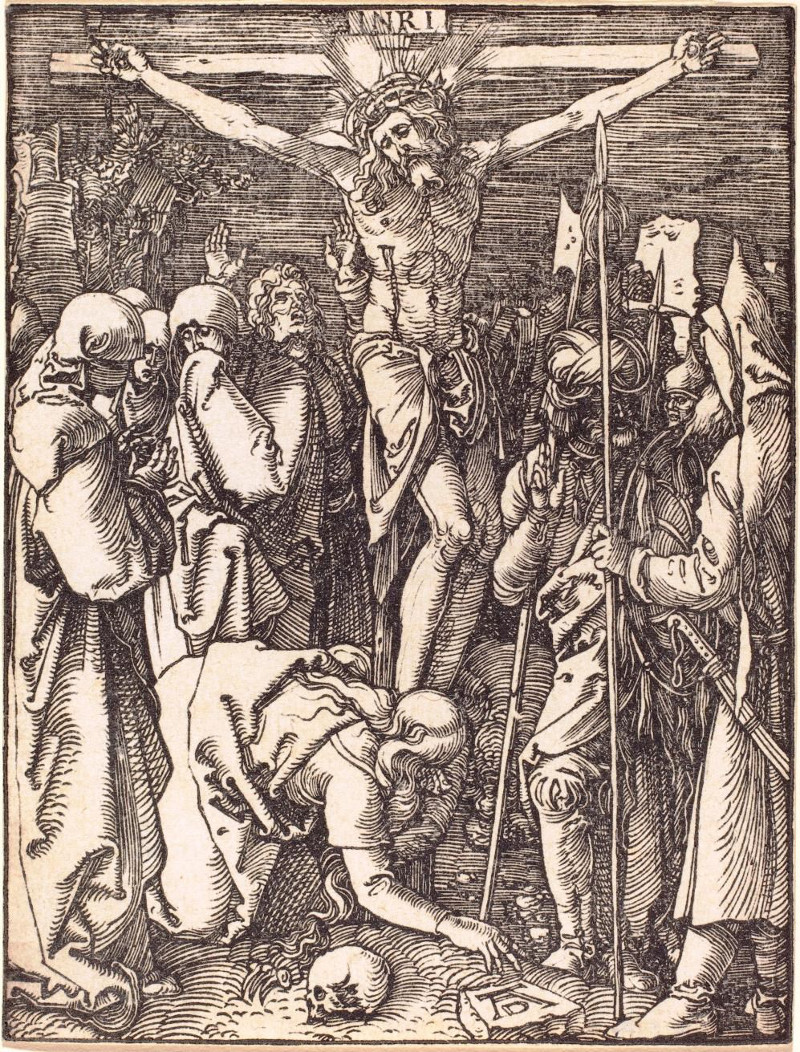

43. Dürer. Christ on the Cross. (Woodcut)
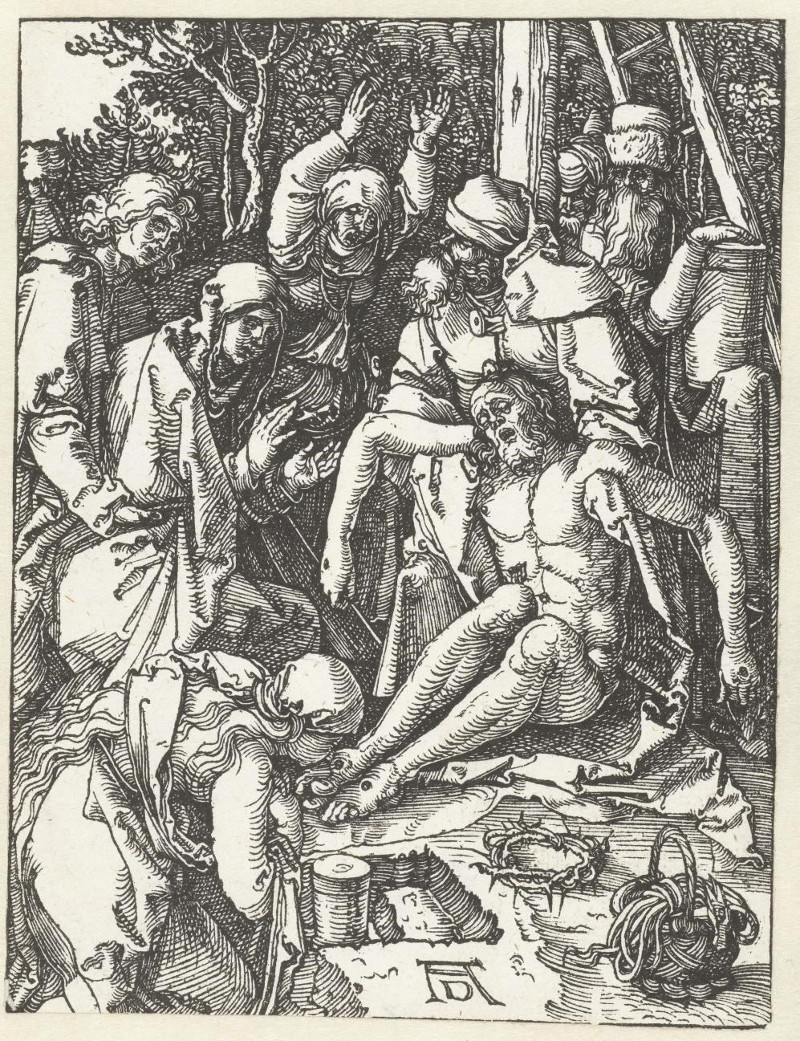

44. Dürer. Mourning for Christ. (Woodcut)
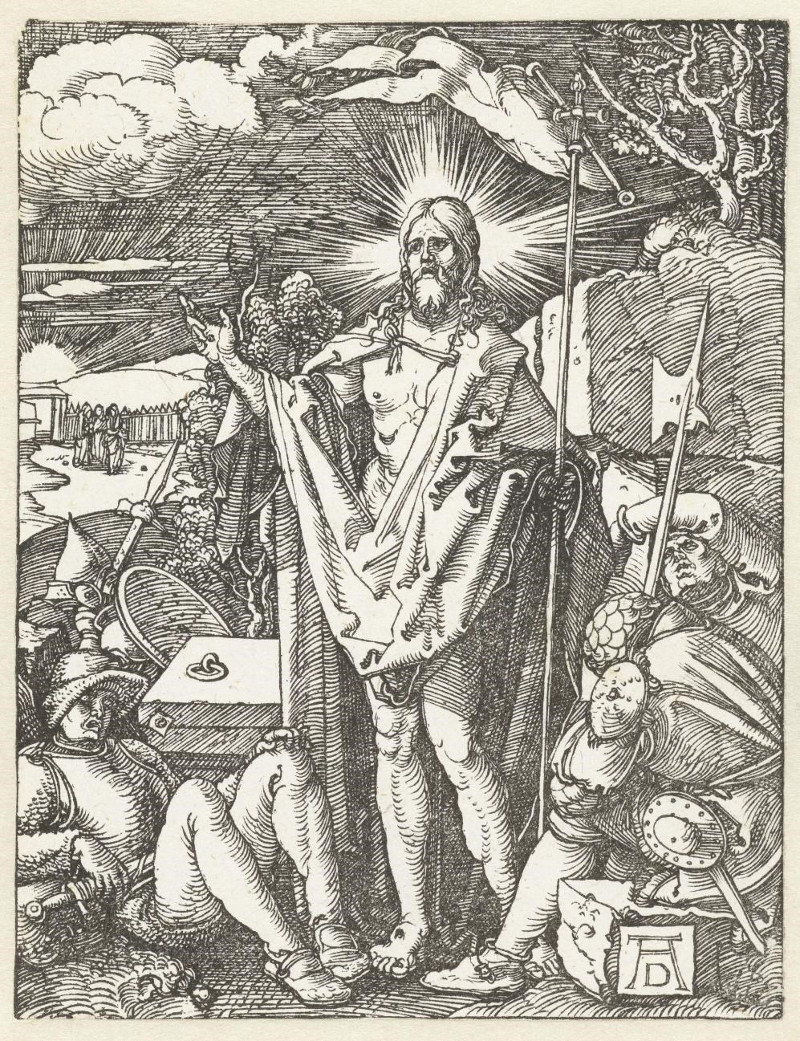

45. Dürer. The Resurrection. (Woodcut)
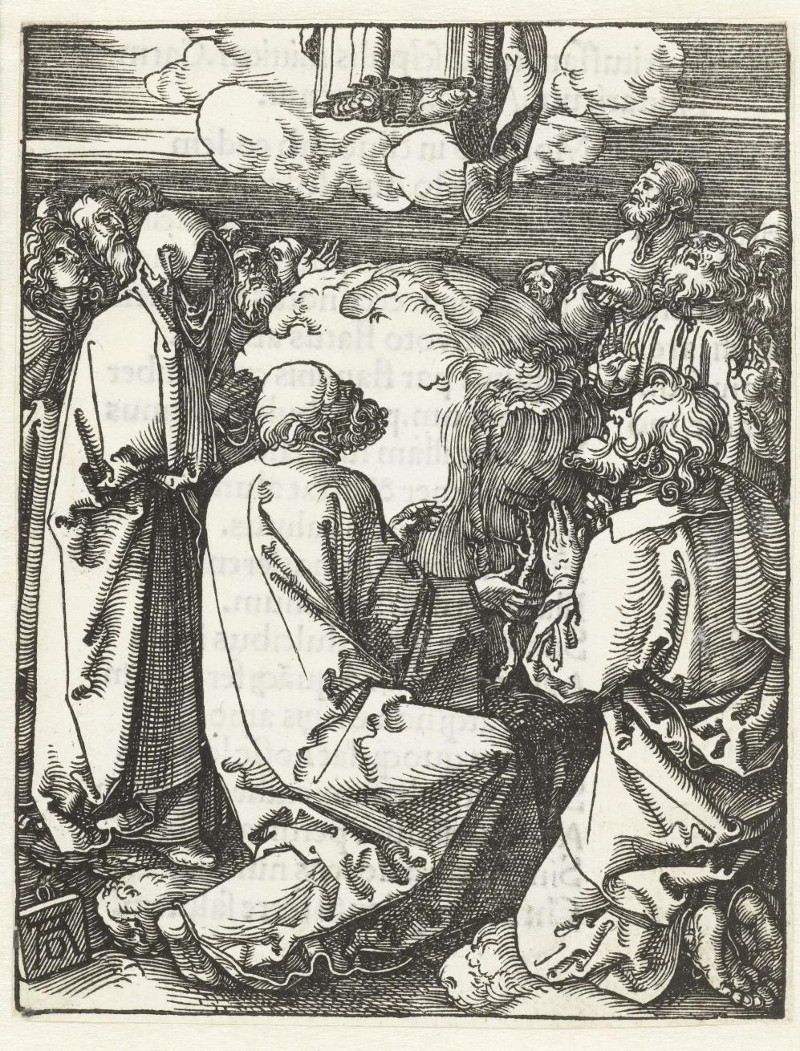

46. Dürer. The Ascension. (Woodcut)
We can also show two pictures by Hans Baldung, who worked for a certain time, at any rate — in Dürer's workshop. These pictures date from the end of the 15th or beginning of the 16th century.


47. Hans Baldung. The Three Fates.
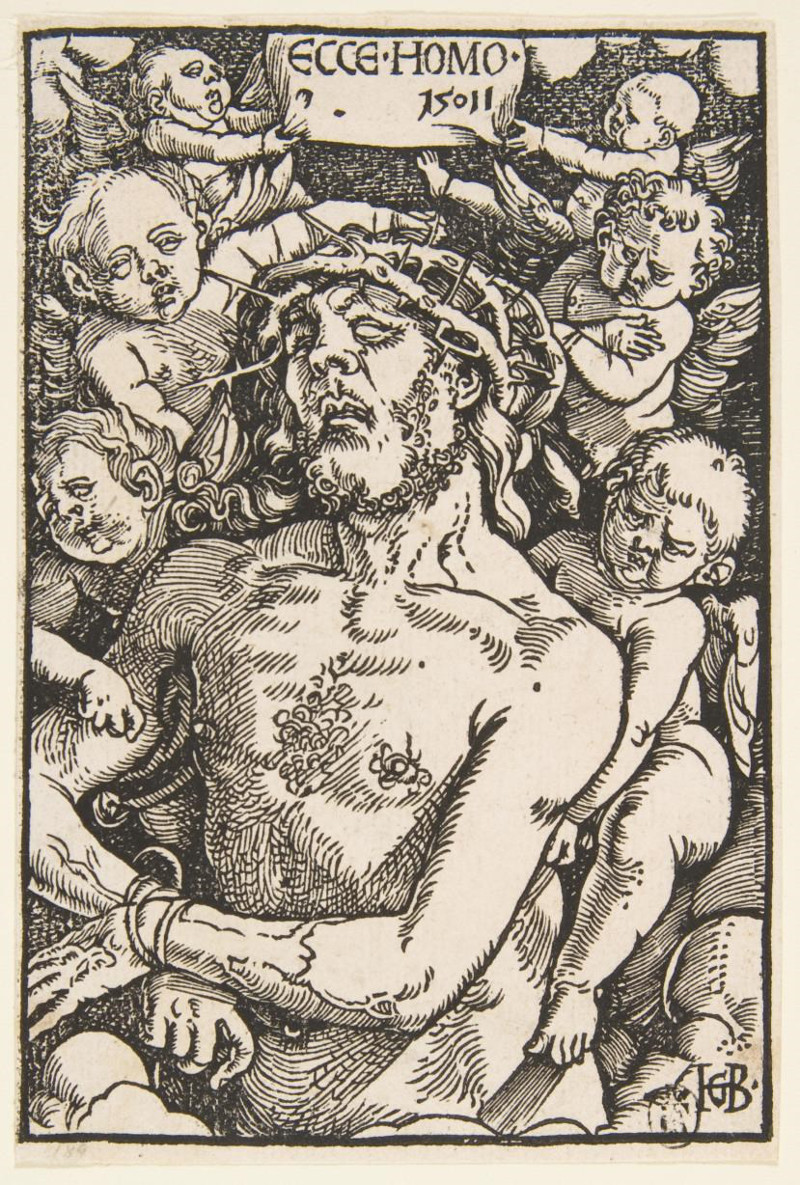

48. Hans Baldung. Ecce Homo.


49. Hans Sebald Beham. The Man of Sorrows.
I would like to make the following remarks: — The transition from the Fourth to the fifth post-Atlantean epoch and all that is connected with it, finds expression — far more than we can realise from the ordinary textbooks of History — in the whole life of the 12th, 13th, 14th, 15th, and 16th centuries. We must remember that at such times, at the turning-point of one epoch and another, many things are perceptible in the life of the time, expressing the mighty transformation that is taking place. History, truly, does not take its course — though the text-books might lead one to suppose so — like a perpetual succession of causes and effects. At characteristic moments, at the turning-points of epochs, characteristic phenomena emerge, in the most varied spheres of life. Thus, at the transition from the age of the Intellectual Soul or Soul of the Higher Feelings to that of the Spiritual Soul, phenomena appear in all domains of life, revealing how men felt when the impulses of the Spiritual Soul were drawing near. The evolution of the Spiritual Soul involved the development of those relationships with the purely physical plane into which men had to enter during the fifth post-Atlantean age. To a high degree, man was about to be fettered to that physical plane. Naturally, this brought in its train all the phenomena of reaction — of opposition and revulsion at this process. Moreover, at the same time many things emerged out of the former epoch, reaching over with multitudinous ramifications into the new.
Among the many symptoms of that time we see, for instance, the intense preoccupation of man with the phenomenon of Death. In many different spheres — as we can easily convince ourselves — the thought of Death came very near to men. Death as a great mystery — the Mystery of Death — drew near to men at the very time when their Souls had to prepare to come out most of all on to the physical plane of existence.
Moreover. the things of the fourth epoch were reaching over into the Fifth. There were the excesses of the Papacy which had degenerated more and more into a pure impulse of might. There were the excesses connected with the old divisions — the riches of the higher orders, their overweening arrogance, their growing superficiality of life, — while the religious themes themselves were being made external, flat and superficial. Those human beings, on the other hand, who attained some inwardness of soul were pondering deeply on the penetration of the Spiritual world into the physical. Added to this, there was the absolute need to turn one's attention to the spiritual world; inasmuch as the seeds of decay and destruction were entering most terribly into the physical world just at that time. For in those centuries the plague was raging far and wide in Europe — truly, an awful death, Death, in the Plague, came face to face with men as a visible phenomenon in its most awful form.
In Art, too, we see this intensive study of the significance of Death. It comes before us especially in the famous Procession of Death on the cemetery wall at Pisa — one of the earliest appearances of this kind. Then we find many pictures of Death as it draws near to men under the inexorable laws of Fate — draws near to man of whatsoever rank or class. The “Dance of Death,” the “Wandering of Death through the World,” Death's entry into all human relationships — this becomes a very favorite theme. It was out of this mood and feeling that Holbein himself created his cycle on the Dance of Death, three examples of which we shall now show. In Holbein's Dance of Death the object was especially to show how Death approaches the rich man, for instance; approaches man of every social rank — from the highest in the land to the lowest. Moreover, the object was to show Death as a righteous judge. Holbein in his Dance of Death desired to show every conceivable circumstance under which Death draws near to human life.


44a. Holbein. Death and the King.
Here we see Death coming to the King, to tear him away from his royal life.


44b. Holbein. Death and the Monk.
The people of that time had great delight in pictures such as these. This was the time when the Reformation strove to put an end to all the growing worldliness and emptiness of the religious life — to the corruption of the Church and the religious orders.


45. Holbein. Death and the Rich Man.
Death draws near to the rich man, and finds him with his pile of money.
My dear friends, we have seen how the German Art came to expression in these great examples — and especially in the greatest, in Dürer, — at the end of the 15th and beginning of the 16th century. One question cannot but interest us again and again: How is it with the origin and evolution of this special stream of Art? In order to say a little more upon this subject, we shall presently show a few pictures revealing how the several factors stood at a characteristic moment. We can make very interesting studies on the evolution of the Mid-European or German Art — and notably the Southern German Art — at the beginning of the 15th century. True, the pictures of the period, which we shall show, give only the outcome of a long line of evolution. But this outcome appears in them strongly and characteristically. When we wish to characterise a great range of phenomena, we have to sum up many things in a few words; and if we desire to be true, it is by no means easy ... It may be that the characteristic pictures we choose does not fully represent all that is here intended. But if we take things on the whole, we shall find it is confirmed, undoubtedly.
The origin of the Mediaeval Art of the German people shows itself most characteristically on the slopes of the Alps reaching out into Southern Germany, into the regions of Southern Bavaria and Swabia. And we must realise that here was a flowing together of two factors. The one represented by all that was imported from the South along the paths of evolution of the Church — and notably the Roman Church system. We must decidedly imagine (though the historic documents contain little about it) that in artistic matters, too, many an impulse came through the Church and the clerical orders. This applies especially to the districts to which I have just referred. Undoubtedly, many priests and clerics also became painters — good and bad — and they, of course, were always in close connection with the whole system of the Church, working its way upwards with its Roman, Latin impulses from the South. They carried with them all that was living there as artistic tradition. Needless to say, this great tradition reached its eminence only in men of genius, but it existed and was taught as a tradition even among lesser men. Tradition was especially at home in Italy, and thence the priests and monks absorbed and carried it with them to the North.
With all the other things which they derived from the Roman Church, they also took with them these conceptions of how the artist should work, ideas of artistic harmony and balance: Of how one ought to group the persons in a picture, and how the lines should go, and so forth. All this that we see at its loftiest eminence, say in the works of Michelangelo and, above all, Raphael, too, did not create naively, but, as I said before, out of a far-reaching artistic tradition. These artists knew how the figures should be grouped, in the composition, how the single figures should be placed, and so forth. And as I mentioned recently, they had brought the laws of perspective to a high degree of perfection.

